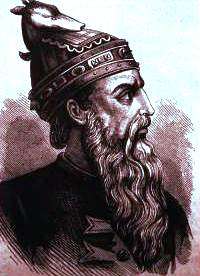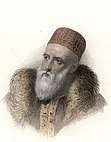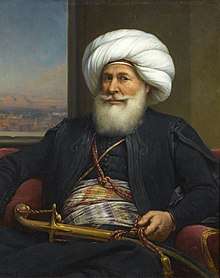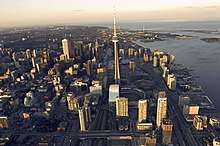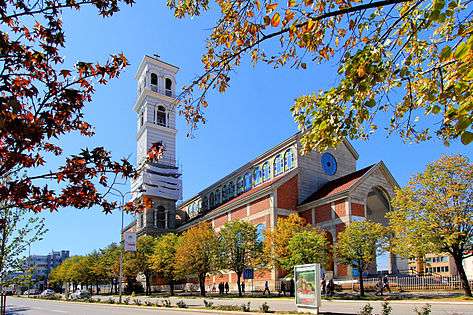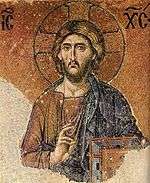Albanians
The Albanians (/ælˈbɛɪniənz/; Albanian: Shqiptarët, pronounced [ʃcipˈta:ɾət]) are an ethnic group native to the Balkan Peninsula and are identified by a common Albanian ancestry, culture, history and language.[61] They primarily live in Albania, Kosovo,[lower-alpha 4] North Macedonia, Montenegro, Serbia as well as in Croatia, Greece and Italy. They also constitute a diaspora with several communities established in the Americas, Europe and Oceania.
Shqiptarët | |||||||||||||||||||||||||
|---|---|---|---|---|---|---|---|---|---|---|---|---|---|---|---|---|---|---|---|---|---|---|---|---|---|
| Total population | |||||||||||||||||||||||||
| c. 7 to 10 million[1][2][3][4][5] | |||||||||||||||||||||||||
| Regions with significant populations | |||||||||||||||||||||||||
| Other regions | |||||||||||||||||||||||||
| |||||||||||||||||||||||||
| |||||||||||||||||||||||||
| |||||||||||||||||||||||||
| |||||||||||||||||||||||||
| |||||||||||||||||||||||||
| |||||||||||||||||||||||||
| |||||||||||||||||||||||||
| |||||||||||||||||||||||||
| Languages | |||||||||||||||||||||||||
| Albanian | |||||||||||||||||||||||||
| Religion | |||||||||||||||||||||||||
| Islam (majority) Sunnism[lower-alpha 1] · Bektashism Christianity (minority) Catholicism[lower-alpha 2] (Latin-rite, Eastern-rite · Albanian Greek Catholic Church · Italo-Albanian Catholic Church) · Eastern Orthodoxy[lower-alpha 3] (Albanian Orthodox Church · Albanian American Orthodox Church) · Protestantism (Albanian Protestant Church · Kosovan Protestant Church) Irreligion Other religions | |||||||||||||||||||||||||
a 502,546 Albanian citizens, an additional 43,751 Kosovo Albanians and 260,000 Arbëreshë people[23][24][60] b Albanians are not recognized as a minority in Turkey. However approximately 500,000 people are reported to profess an Albanian identity. Of those with full or partial Albanian ancestry and others who have adopted Turkish language, culture and identity their number is estimated at 1,300,000–5,000,000 many whom do not speak Albanian.[27] c The estimation contains Kosovo Albanians. | |||||||||||||||||||||||||
| Part of a series on |
| Indo-European topics |
|---|
 |
|
|
Philology
|
|
Origins |
|
Archaeology Pontic Steppe
Caucasus East Asia Eastern Europe Northern Europe Pontic Steppe Northern/Eastern Steppe Europe
South Asia Steppe Europe Caucasus India |
|
Peoples and societies Indo-Aryans Iranians
East Asia Europe East Asia Europe
Indo-Aryan Iranian
|
|
Religion and mythology
Indo-Aryan Iranian Others Europe
|
|
The ethnogenesis of the Albanians and their language is a matter of controversy among historians and ethnologists. They were mentioned for the first time in historical records from the 11th century as a tribe of people living across the mountainous region of the Mat and Drin.[62][63] The Shkumbin more southerly splits the Albanians into the Ghegs and Tosks nevertheless both groups identify with a shared ethnic culture, history and traditions.
The history of the Albanian diaspora is centuries old and has its roots in migration from the Middle Ages initially established in Southern Europe and subsequently on across other parts of Europe and the New World. Between the 13th and 18th centuries, sizeable numbers of Albanians migrated to escape either various social, economic or political difficulties.[lower-alpha 5]
One population, the Arvanites, settled Southern Greece between the 13th and 16th centuries assimilating into and now self-identifying as Greeks.[lower-alpha 6] Another population who emerged as the Arbëreshë settled Sicily and Southern Italy.[65] Smaller populations such as the Arbanasi whose migration dates back to the 18th century are located in Southern Croatia and scattered across Southern Ukraine.[73][74]
The Great Schism of 1054 formalised the break of communion between the Eastern Orthodox and Western Catholic Church and was instantly reflected in Albania through the emergence of a Catholic north and Orthodox south. Inhabiting the west of Lake Ochrida and the upper valley of River Shkumbin, the Albanians established the Principality of Arbanon in 1190 with the capital in Krujë. In the 13th century, the Ghegs converted to Roman Catholicism in larger numbers from Eastern Orthodoxy as a means to resist the pressure of Slavic Serbs.[75][76][77]
In the 15th century, the expanding Ottoman Empire overpowered the Balkan Peninsula and so the Albanians. Their consequent resistance to Ottoman expansion into Europe led by Gjergj Kastrioti Skanderbeg won them acclaim all over Europe. In the 17th and 18th centuries, a substantial number of Albanians converted to Islam offering them equal opportunities and advancement within the Ottoman Empire.[78][79][80][81][82][83] Hence, they attained significant positions and culturally contributed to the broader Muslim world.[84]
The Ottomans had cut the Albanians off from significant European intellectual movements, amongst them the Renaissance and Enlightenment, and these ideas together with the ideals of Nationalism traditionally began to reach the Albanians through the Albanian diaspora conclusively leading to the Albanian Renaissance which was also incorporated with the influences of Romanticism.
During the Balkan Wars, the Albanians were partitioned between Independent Albania, Greece, Montenegro, and Serbia.[85] After the Second World War until the Revolutions of 1991, Albania was governed by a communist government launching the Albanians on a path of oppression and decades of isolation. Though in neighbouring Yugoslavia, Albanians underwent periods of discrimination that concluded with the Breakup of Yugoslavia and eventually the Independence of Kosovo.
Ethnonym
The Albanians (Albanian: Shqiptarët) and their country Albania (Albanian: Shqipëria) have been identified by many ethnonyms. The most common native ethnonym is "Shqiptar", plural "Shqiptarë"; the name "Albanians" (Byzantine Greek: Albanoi/Arbanitai/Arbanites; Latin: Albanenses/Arbanenses) was used in medieval documents, that gradually entered European Languages from which other similar derivative names emerged.[86]
From these ethnonyms, names for Albanians were also derived in other languages, that were or still are in use.[87][88][89] In English "Albanians"; Italian "Albanesi"; German "Albaner"; Greek "Arvanites", "Alvanitis" (Αλβανίτης) plural: "Alvanites" (Αλβανίτες), "Alvanos" (Αλβανός) plural: "Alvanoi" (Αλβανοί); Turkish "Arnaut", "Arnavut"; South Slavic languages "Arbanasi" (Арбанаси), "Albanci" (Албанци); Aromanian "Arbineş" and so on.[lower-alpha 7]
The term "Albanoi" (Αλβανοί) is first encountered twice in the works of Byzantine historian Michael Attaliates, and the term "Arvanitai" (Αρβανίται) is used once by the same author. He referred to the "Albanoi" as having taken part in a revolt against the Byzantine Empire in 1043, and to the "Arbanitai" as subjects of the Duke of Dyrrachium (modern Durrës).[92] These references have been disputed as to whether they refer to the people of Albania.[92][93] Historian E. Vranoussi believes that these "Albanoi" were Normans from Sicily. She also notes that the same term (as "Albani") in medieval Latin meant "foreigners".[94]
The reference to "Arvanitai" from Attaliates regarding the participation of Albanians in a rebellion around 1078 is undisputed.[95] In later Byzantine usage, the terms "Arbanitai" and "Albanoi" with a range of variants were used interchangeably, while sometimes the same groups were also called by the classicising name Illyrians.[96][97][98] The first reference to the Albanian language dates to the latter 13th century (around 1285).[99]
The ethnonym Albanian has been hypothesized to be connected to and stem from the Albanoi,[100][101][102] an Illyrian tribe mentioned by Ptolemy with their centre at the city of Albanopolis.[87][103] Linguists believe that the alb part in the root word originates from an Indo-European term for a type of mountainous topography, from which other words such as alps are derived.[104] Through the root word alban and its rhotacized equivalents arban, albar, and arbar, the term in Albanian became rendered as Arbëneshë/Arbëreshë for the people and Arbënia/Arbëria for the country.[86][87] The Albanian language was referred to as Arbnisht and Arbërisht.[103] While the exonym Albania for the general region inhabited by the Albanians does have connotations to Classical Antiquity, the Albanian language employs a different ethnonym, with modern Albanians referring to themselves as Shqip(ë)tarë and to their country as Shqipëria.[87] Two etymologies have been proposed for this ethnonym: one, derived from the etymology from the Albanian word for eagle (shqipe, var., shqiponjë).[89] In Albanian folk etymology, this word denotes a bird totem, dating from the times of Skanderbeg as displayed on the Albanian flag.[89][105] The other is within scholarship that connects it to the verb 'to speak' (me shqiptue) from the Latin "excipere".[89] In this instance the Albanian endonym like Slav and others would originally have been a term connoting "those who speak [intelligibly, the same language]".[89] The words Shqipëri and Shqiptar are attested from 14th century onward,[106] but it was only at the end of 17th and beginning of the early 18th centuries that the placename Shqipëria and the ethnic demonym Shqiptarë gradually replaced Arbëria and Arbëreshë amongst Albanian speakers.[87][106] That era brought about religious and other sociopolitical changes.[87] As such a new and generalised response by Albanians based on ethnic and linguistic consciousness to this new and different Ottoman world emerging around them was a change in ethnonym.[87]
Historical records
Little is known about the Albanian people prior to the 11th century, though a text compiled around the beginning of the 11th century in the Bulgarian language contains possibly a reference to the Albanian people.[107] It is preserved in a manuscript written in the Serbo-Croatian Language traced back to the 17th century but published in the 20th century by Radoslav Grujic. It is a fragment of a once longer text that endeavours to explain the origins of peoples and languages in a question-and-answer form similar to a catechism.
The fragmented manuscript differentiated the world into seventy-two languages and three religious categories including Christians, half-believers and non-believers. Grujic dated it to the early 11th century and if this and the identification of the Arbanasi, as Albanians, are correct it would be the earliest written document referring to the Albanian people as a people or language group.[107]
It can be seen that there are various languages on earth. Of them, there are five Orthodox languages: Bulgarian, Greek, Syrian, Iberian (Georgian) and Russian. Three of these have Orthodox alphabets: Greek, Bulgarian and Iberian (Georgian). There are twelve languages of half-believers: Alamanians, Franks, Magyars (Hungarians), Indians, Jacobites, Armenians, Saxons, Lechs (Poles), Arbanasi (Albanians), Croatians, Hizi and Germans.
The first undisputed mention of Albanians in the historical record is attested in Byzantine source for the first time in 1079–1080, in a work titled History by Byzantine historian Michael Attaliates, who referred to the Albanoi as having taken part in a revolt against Constantinople in 1043 and to the Arbanitai as subjects of the duke of Dyrrachium. It is disputed, however, whether the "Albanoi" of the events of 1043 refers to Albanians in an ethnic sense or whether "Albanoi" is a reference to Normans from Sicily under an archaic name (there was also a tribe in Italy by the name of "Albanoi").[92] However a later reference to Albanians from the same Attaleiates, regarding the participation of Albanians in a rebellion around 1078, is undisputed.[95] At this point, they are already fully Christianized, although Albanian mythology and folklore are part of the Paleo-Balkan pagan mythology,[108] in particular showing Greek influence.[109]
Language
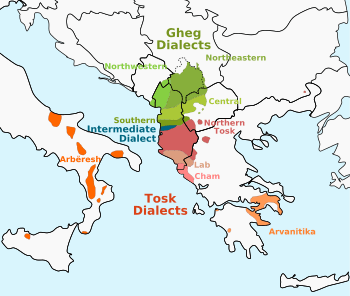
The majority of the Albanian people speak the Albanian language which comprises an independent branch within the Indo-European family of languages. It is a language isolate to any other known living language in Europe and indeed no other language in the world has been conclusively associated to its branch. Its origin remains conclusively unknown but it is believed it has descended from an ancient Paleo-Balkan language.
The Albanian language is spoken by approximately 5 million people throughout the Balkan Peninsula as well as by a more substantial number by communities around the Americas, Europe and Oceania. Numerous variants and dialects of Albanian are used as an official language in Albania, Kosovo and North Macedonia.[110][111][112][113] The language is also spoken in other countries whence it is officially recognised as a minority language in such countries as Croatia, Italy, Montenegro, Romania and Serbia.[114][115][116]
There are two principal dialects of the Albanian language traditionally represented by Gheg and Tosk.[117][118] The ethnogeographical dividing line is traditionally considered to be the Shkumbin with Gheg spoken in the north of it and Tosk in the south. Dialects spoken in Croatia (Arbanasi and Istrian), Kosovo, Montenegro and Northwestern North Macedonia are Gheg dialects, while those dialects spoken in Greece (Arvanites and Çam), Southwestern North Macedonia and Italy (Arbëreshë) are Tosk dialects.
The Arbëreshë and Arvanitika languages represent varieties of the Albanian language spoken by the Arbëreshës and Arvanites in Southern Italy and Southern Greece respectively. They retain elements of medieval Albanian vocabulary and pronunciation that are no longer used in modern Albanian language however both varieties are classified as endangered languages in the UNESCO Red Book of Endangered Languages.[119][120][121]
Most of the Albanians in Albania and the Former Yugoslavia are polyglot and have the ability to understand, speak, read, or write a foreign language. As defined by the Institute of Statistics of Albania, 39.9% of the 25 to 64 years old Albanians in Albania are able to use at least one foreign language including English (40%), Italian (27.8%) and Greek (22.9%).[122]
The origin of the Albanian language remains a contentious subject that has given rise to numerous hypotheses. The hypothesis of Albanian being one of the descendant of the Illyrian languages is based on geography where the languages were spoken however not enough archaeological evidence is left behind to come therefore to a definite conclusion. Another hypothesis associates the Albanian language with the Thracian language. This theory takes exception to the territory, since the language was spoken in an area distinct from Albania, and no significant population movements have been recorded in the period when the shift from one language to the other is supposed to have occurred.[123]
History
Middle Ages
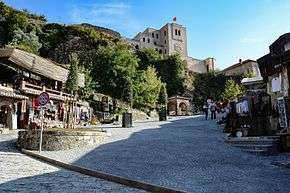
The Albanian people maintain a very chequered and tumultuous history behind them, a fact explained by their geographical position in the Southeast of Europe at the cultural and political crossroad between the east and west, even though they have often been isolated from the mainstream history of Europe.
The issue surrounding the origin of the Albanian people has been long debated by historians and linguists for centuries. Many scholars consider the Albanians, in terms of linguistic evidences, the descendant population of ancient populations of the Balkan Peninsula, either the Illyrians, Thracians or another Paleo-Balkan group.[124] There are insufficient evidences to derive an accurate conclusion and therefore Albanian origins still remain a mystery.
Historically known as the Arbër or Arbën by the 11th century and onwards, they traditionally inhabited the mountainous area to the west of Lake Ochrida and the upper valley of the River Shkumbin.[125][126] Though it was in 1190 when they established their first independent entity with their seat based in Krujë.[127] Immediately after the decline of the Progon dynasty in 1216, the principality came under Grigor Kamona and Gulam of Albania. Finally the Principality was dissolved in 1255. Around 1230 the two main centers of Albanian settlements, one around Devoll river in what is now central Albania,[128] and the other around the region which was known with the name Arbanon.[129]
In 1271 Charles of Anjou created the Kingdom of Albania, after he captured a part of the Despotate of Epirus.[130] A major attempt to advance further in direction of Constantinople failed at the Siege of Berat (1280–1281). A Byzantine counteroffensive soon ensued, which drove the Angevins out of the interior by 1281. The Sicilian Vespers further weakened the position of Charles, and the Kingdom was soon reduced by the Epirotes to a small area around Durrës. The kingdom however held out until 1368, when the city was captured by Karl Thopia. The presence of the kingdom reinforced the influence of Catholicism and the conversion to its rite, not only in the region of Durrës but in other parts of the country.[131] A new wave of Catholic dioceses, churches and monasteries were founded, a number of different religious orders began spreading into the country, and papal missionaries also reached the territories of the Kingdom of Albania. Those who were not Catholic in Central and North Albania converted and a great number of Albanian clerics and monks were present in the Dalmatian Catholic institutions.[132]
The history of Albanian presence in Croatia can be traced back to the Middle Ages.[133] In this period, there was a significant Albanian community in Ragusa with numerous families of Albanian origin inclusively the Sorgo family who came from the Cape of Rodon in central Albania, across Kotor in eastern Montenegro, to Dalmatia.[134] By the 13th century, Albanian merchants were trading directly with the peoples of the Republic of Ragusa which increased familiarity between Albanians and Ragusans.[135] The upcoming invasion of Albania by the Ottoman Empire and the death of Skanderbeg caused many Christian Albanians to flee to Dalmatia and other countries including Italy and Greece.[136][137][73]
In the 14th century a number of Albanian principalities were created. These included Principality of Kastrioti, Principality of Dukagjini, Princedom of Albania, and Principality of Gjirokastër. At the beginning of the 15th century these principalities became stronger, especially because of the fall of the Serbian Empire. Some of these principalities were united in 1444 under the military alliance called League of Lezha.
Albanians were recruited all over Europe as a light cavalry known as stratioti. The stratioti were pioneers of light cavalry tactics during the 15th century. In the early 16th century heavy cavalry in the European armies was principally remodeled after Albanian stradioti of the Venetian army, Hungarian hussars and German mercenary cavalry units (Schwarzreitern).[138]
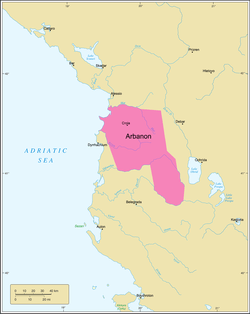

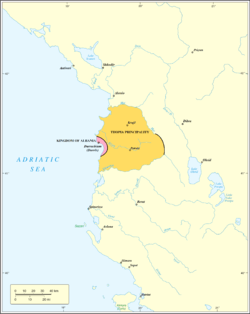
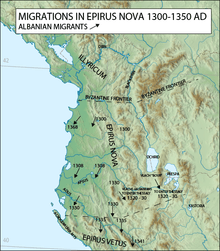
Ottoman Empire
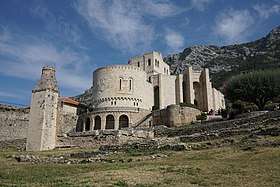
Prior to the Ottoman conquest of Albania, the political situation of the Albanian people was characterised by a fragmented conglomeration of scattered kingdoms and principalities such as the Principalities of Arbanon, Kastrioti and Thopia. However, after the fall of Constantinople, the Ottoman Empire continued an extended period of conquest and expansion with its borders going deep into the Southeast Europe. As a consequence thousands of Albanians from Albania, Epirus and Peloponnese escaped to Western Europe, particularly to Calabria, Naples, Ragusa and Sicily, whereby others sought protection at the often inaccessible Mountains of Albania.
Under the leadership of Gjergj Kastrioti Skanderbeg, a prosperous and longstanding revolution erupted with the formation of the Assembly of Lezhë up until the Siege of Shkodër, multiple times defeating the mightiest power of the time led by Sultans Murad II and Mehmed II. Skanderbeg managed to gather several of the Albanian principals, amongst them the Arianitis, Dukagjinis, Zaharias and Thopias, and establish a centralised authority over most of the non-conquered territories instantly becoming the Lord of Albania.[141]
Skanderbeg consistently pursued the aim relentlessly but rather unsuccessfully to create a European coalition against the Ottomans. He defeated every attempt by the Ottomans to regain Albania which they envisioned as a springboard for the invasion of Italy and Western Europe. His unequal fight against them won the esteem of Europe also among others financial and military aid from the Papacy and Naples, Venice and Ragusa.[139][142][143]
The Albanians, predominantly a Christian people, were considered as an inferior class of people and as such they were subjected to heavy taxes such as the Devshirme system that allowed the Sultan to collect a requisite percentage of Christian adolescents from the Balkans and elsewhere to compose the Janissary.[144] Since the Albanians were seen as strategically important, they made up a significant proportion of the Ottoman military and bureaucracy. They were therefore to be found within the imperial services as vital military and administrative retainers from Egypt to Algeria and the rest of Maghreb.[145]
In the late 18th century, Ali Pasha Tepelena created the autonomous region of the Pashalik of Yanina within the Ottoman Empire which was never recognised as such by the High Porte. The territory he properly governed incorporated most of southern Albania, Epirus, Thessaly and southwestern Macedonia. During his rule, the town of Janina blossomed into a cultural, political and economic hub for both Albanians and Greeks.
The ultimate goal of Ali Pasha Tepelena seems to have been the establishment of an independent rule in Albania and Epirus.[146] Thus, he obtained control of Arta and took control over the ports of Butrint, Preveza and Vonitsa. He also gained control of the pashaliks of Elbasan, Delvina, Berat and Vlorë. His relations with the High Porte were always tense though he developed and maintained relations with the British, French and Russian people and formed an alliance with them through various times.[147]
In the 19th century, the Albanian wālī Muhammad Ali established a dynasty that ruled over Egypt and Sudan until the middle of the 20th century.[148] After a brief French invasion led by Napoleon Bonaparte and the Ottomans and Mameluks competing for power there, he managed collectively with his Albanian troops to become the Ottoman viceroy in Egypt.[149] As he revolutionised the military and economic spheres of Egypt, his empire attracted the Albanian people contributing to the emergence of the Albanian diaspora in Egypt who had initially formed by Albanian soldiers and mercenaries.
Islamisation

Islam arrived in the lands of the Albanian people gradually and became primarily widespread at least from the 17th century up till the 18th century.[84] The new religion brought many transformations into the Albanian society and hence offered them equal opportunities and advancement within the Ottoman Empire.
With the advent of increasing suppression on Catholicism, the Ottomans initially focused their conversion campaigns on the Catholic Albanians of the north in the 17th century and followed suit in the 18th century on the Orthodox Albanians of the south.[150][151] At this point, the urban centers of central and southern Albania had largely adopted the new religion of the growing Muslim Albanian elite. Many mosques and tekkes were constructed throughout those urban centers and cities such as Berat, Gjirokastër, Korçë and Shkodër started to flourish.[152] In the far north, the spread of Islam was slower due to Catholic Albanian resistance and the inaccessible and rather remote mountainous terrain.[153]

The motives for conversion to Islam are subject to differing interpretations according to scholars depending on the context though the lack of sources does not help when investigating such issues.[84] Reasons included the incentive to escape high taxes levied on non-Muslims subjects, ecclesiastical decay, coercion by Ottoman authorities in times of war and the privileged legal and social position Muslims within the Ottoman administrative and political machinery had over that of non-Muslims.[154][81][82][83][79][78][80]
As Muslims, the Albanians attained powerful positions in the Ottoman administration over three dozen Grand Viziers of Albanian origin, among them members of the Köprülü family, Zagan Pasha, Bayezid Pasha, Muhammad Ali of Egypt and Ali Pasha of Tepelena; the Sultans Bayezid II and Mehmed III were both of Albanian origin on the maternal side.[155][156]
Areas such as Albania, Western Macedonia, Southern Serbia, Kosovo, parts of northern Greece and southern Montenegro in Ottoman sources were referred to as Arnavudluk or Albania.[157][158][159]
Albanian Renaissance
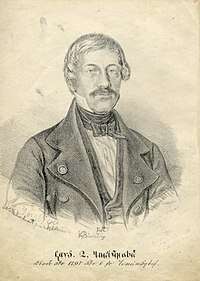
The Albanian Renaissance characterised a period wherein the Albanian people gathered both spiritual and intellectual strength to establish their rights for an independent political and social life, culture and education. By the late 18th century and the early 19th century, its foundation arose within the Albanian communities in Italy and Romania and was frequently linked to the influences of the Romanticism and Enlightenment principles.[161]
Albania was under the rule of the Ottoman Empire for almost five centuries and the Ottoman authorities suppressed any expression of unity or national conscience by the Albanian people. A number of thoroughly intellectual Albanians, among them Naum Veqilharxhi, Girolamo de Rada, Dora d'Istria, Thimi Mitko, Naim and Sami Frashëri, made a conscious effort to awaken feelings of pride and unity among their people by working to develop Albanian literature that would call to mind the rich history and hopes for a more decent future.[162]
The Albanians had poor or often no schools or other institutions in place to protect and preserve their cultural heritage. The need for schools was preached initially by the increasing number of Albanians educated abroad. The Albanian communities in Italy and elsewhere were particularly active in promoting the Albanian cause, especially in education which finally resulted with the foundation of the Mësonjëtorja in Korçë, the first secular school in the Albanian language.
The Turkish yoke had become fixed in the nationalist mythologies and psyches of the people in the Balkans, and their march toward independence quickened. Due to the more substantial of Islamic influence, the Albanians internal social divisions, and the fear that they would lose their Albanian territories to the emerging neighbouring states, Serbia, Montenegro, Bulgaria and Greece, were among the last peoples in the Balkans to desire division from the Ottoman Empire.[163]
The national awakening as a coherent political movement emerged after the Treaty of San Stefano, according to which Albanian-inhabited territories were to be ceded to the neighbouring states, and focused on preventing that partition.[164][165] It was the impetus for the nation-building movement, which was based more on fear of partition than national identity.[165] Even after the declaration of independence, national identity was fragmented and possibly non-existent in much of the newly proposed country.[165] The state of disunity and fragmentation would remain until the communist period following Second World War, when the communist nation-building project would achieve greater success in nation-building and reach more people than any previous regime, thus creating Albanian national communist identity.[165]
Communism in Albania
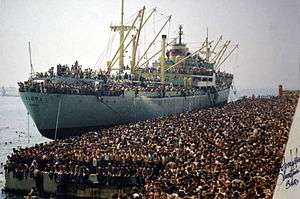
Enver Hoxha of the Party of Labour took immediate and forceful measures for the total power over the nation state of the Albanian people, Albania in 1946. As the regimes strength began to increase, Enver Hoxha established an alliance with the Eastern Bloc which provided Albania with many advantages in the form of economic assistance and military protection from the Western Bloc during the Cold War.
The Albanians experienced a period of several beneficial political and economic changes. The government defended the territorial integrity and sovereignty of Albania, diversified the economy through a programme of industrialisation which led to a higher standard of living and followed improvements in areas such as health, education and infrastructure.[166]
It subsequently followed a period wherein the Albanians lived within an extreme isolation from the rest of the world for the next four decades. By 1967, the established government had officially proclaimed Albania to be the first atheistic state in the world as they beforehand confiscated churches, monasteries and mosques, and any religious expression instantly became grounds for imprisonment.[167]
Effective protests with the emerging revolutions of 1989 began to break out in various cities throughout Albania including Shkodër and Tirana which eventually caused the fall of communism. Finally as the communism came to a violent end in 1992, both internal and large external migration waves of Albanians, in such countries as Greece and Italy, has taken place on a massive scale over the forthcoming years in Albania.
The bunkerisation is arguably the most visible and memorable legacy of the communism in Albania. Nearly 175.000 reinforced concrete bunkers were built on strategic locations across Albania's territory including near borders, within towns, on the seashores or mountains.[168] These bunkers were never used for their intended purpose or for sheltered the population from attacks or an invasion by a neighbor. However, they were abandoned after the breakup of communism and have been sometimes reused for a variety of purposes.
Independence of Kosovo

Kosovo declared independence from Serbia on 17 February 2008, after years of strained relations between the Serb and predominantly Albanian population of Kosovo. It has been officially recognised by Australia, Canada, the United States and major European Union countries, while Serbia and its ally Russia refuse to recognise Kosovo's sovereignty.
The overwhelming majority of Kosovo's population is ethnically Albanian with nearly 1.7 million people.[169] Their presence as well as in the adjacent regions of Toplica and Morava is recorded since the Middle Ages.[170] As the Serbs expelled many Albanians from the wider Toplica and Morava regions in Southern Serbia, which the 1878 Congress of Berlin had given to the Principality of Serbia, many of them settled in Kosovo.[171][172][173]
After being an integral section of the Kingdom of Yugoslavia, Kosovo including its Albanian population went through a period of discrimination, economic and political persecution.[174] Rights to use the Albanian language were guaranteed by the constitution of the later formed Socialist Yugoslavia and was widely used in Macedonia and Montenegro prior to the dissolution of Yugoslavia.[175] In 1989, Kosovo lost its status as a federal entity of Yugoslavia with rights similar to those of the six other republics and eventually became part of Serbia and Montenegro.
In 1998, tensions between the Albanian and Serb population of Kosovo simmered and erupted into major violence and discrimination culminating into the humanitarian tragedy of the Kosovo War. The conflict led to the displacement of hundred thousands of Albanians to the neighboring countries and Europe. Serbian paramilitary forces committed war crimes in Kosovo, although the government of Serbia claims that the army was only going after suspected Albanian terrorists. The NATO launched a 78-day air campaign in 1999 to halt the humanitarian catastrophe that was then unfolding in Kosovo and finally concluded the ended the war.[176]
Distribution
Balkans

Approximately 5 million Albanians are geographically distributed across the Balkan Peninsula with about half this number living in Albania, Kosovo, North Macedonia and Montenegro as well as to a more lesser extent in Croatia and Serbia. There are also significant Albanian populations in Greece while much smaller communities are available in nearby Bulgaria and Romania.
In Montenegro, the Albanian population is currently estimated to be around 30.000 forming one of the constituent ethnic minority groups of the country.[31][177] They predominantly live in the coastal region of Montenegro around the municipalities of Ulcinj and Bar but also around Plav in the northern region as well as in the capital city of Podgorica in the central region.[31]
In North Macedonia, there are more than approximately 500.000 Albanians constituting the largest ethnic minority group in the country.[29][30] The vast majority of the Albanians are chiefly concentrated around the municipalities of Tetovo and Gostivar in the northwestern region, Struga and Debar in the southwestern region as well as around the capital of Skopje in the central region.
.jpg)
In Croatia, the number of Albanians stands at approximately 17.500 mostly concentrated in the counties of Istria, Split-Dalmatia and most notably in the capital city of Zagreb.[179][114] The Arbanasi people who historically migrated to Bulgaria, Croatia and Ukraine live in scattered communities across Bulgaria, Croatia and Southern Ukraine.[74]
In Serbia, the Albanians are an officially recognised ethnic minority group with a population of around 70.000.[180] They are significantly concentrated in the municipalities of Bujanovac and Preševo in the Pčinja District. In Romania, the number of Albanians is unofficially estimated from 500 to 10.000 mainly distributed in Bucharest. They are recognised as an ethnic minority group and are respectively represented in Parliament of Romania.[181][182]
Approximately 1.7 million Albanians are concentrated in the partially recognised Republic of Kosovo[lower-alpha 4] and their numbers are increasing year by year. They are geographically distributed south of the municipality of North Mitrovica and constitute the overall majority ethnic group of the territory.
Italy
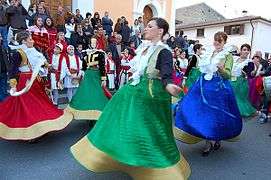
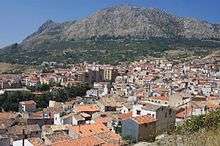
The Italian Peninsula across the Adriatic Sea has attracted the Albanian people for more than half a millennium often due to the immediate proximity and the consideration as the primary gateway to Western Europe. Albanians in Italy were those who later became important in establishing the fundamentals of the Albanian Renaissance and maintaining the Albanian culture.
The Arbëreshë people came sporadically in several small and large cycles to Italy initially as mercenaries in the service for the Neapolitans, Sicilians and Venetians.[183][184][185] Larger migration waves occurred after the death of Skanderbeg and the capture of Krujë and Shkodër by the Ottomans to escape the forthcoming political and religious changes.[186]
Today, the Albanian people constitute one of the largest ethnolinguistic minority groups of Italy and their status are protected by law.[187][188][189] The total number of Arbëreshës is approximately 260,000 scattered across Sicily, Calabria and Apulia.[65] There are numbers outside Italy such as in the Americas especially in such countries as Argentina, Canada, Chile, Uruguay and the United States.
Centuries later in the end of the 20th century occurred another and simultaneously the largest migration cycle of Albanians to Italy surpassing the earlier migration of the Arbëreshë. Their migration stems from severe political and social oppression during decades of isolation from the outside world under the communist regime led by Enver Hoxha.[190]
Between 2015 and 2016, the number of Albanians regularly residing in Italy was numbered to be around 480,000 and 500,000.[190][191] Tuscany, Lombardy and Emilia-Romagna represent the regions with the strongest presence of the modern Albanian population in Italy.[190] In 2012, 41.5% of the Albanian population were counted as Muslim, 38.9% as Christian including 27.7% as Roman Catholic and 11% as Eastern Orthodox and 17.8% as Irreligious.[192]
Greece
An estimated 275,000–600,000 (Includes dual citizens, temporary migrants, and undocumented) Albanians live in Greece, forming the largest immigrant community in the country.[193] They are economic migrants whose migration began in 1991, following the collapse of the Socialist People's Republic of Albania.
The Arvanites and Albanian-speakers of Western Thrace are a group descended from Tosks who migrated to southern and central Greece between the 13th and 16th centuries.[66] They are Greek Orthodox Christians, and though they traditionally speak a dialect of Tosk Albanian known as Arvanitika, they have fully assimilated into the Greek nation and do not identify as Albanians.[67][68][72] Arvanitika is in a state of attrition due to language shift towards Greek and large-scale internal migration to the cities and subsequent intermingling of the population during the 20th century.
The Cham Albanians were a group that formerly inhabited a region of Epirus known as Chameria, nowadays Thesprotia in northwestern Greece. Many Cham Albanians converted to Islam during the Ottoman era. Muslim Chams were expelled from Greece during World War II, by an anti-communist resistance group, as a result of their participation in a communist resistance group and the collaboration with the Axis occupation, while Orthodox Chams have largely assimilated into the Greek nation.
Diaspora
Europe
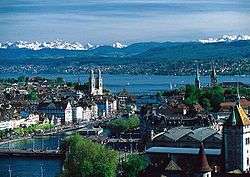
During the end of the 20th and the beginning of the 21st centuries, the conflicts in the Balkans and the Kosovo War set in motion large population movements of Albanians to Central, Western and Northern Europe.[195] The gradual collapse of communism in Albania triggered as well a new wave of migration and contributed to the emergence of a new diaspora, mainly in Southern Europe, in such countries as Greece and Italy.[196][197][198]
In Central Europe, there are approximately 200,000 Albanians in Switzerland with the particular concentration in the cantons of Zürich, Basel, Lucerne, Bern and St. Gallen.[41][194] The neighbouring Germany is home to around 250,000 to 300,000 Albanians while in Austria there are around 40,000 to 80,000 Albanians concentrated in the states of Vienna, Styria, Salzburg, Lower and Upper Austria.[39][40][199][200]
In Western Europe, the Albanian population of approximately 10,000 people living in the Benelux countries is in comparison to other regions relatively limited. There are more than 6,000 Albanian people living in Belgium and 2,800 in the nearby Netherlands. The most lesser number of Albanian people in the Benelux region is to be found in Luxembourg with a population of 2,100.[201][47][48]
Within Northern Europe, Sweden possesses the most sizeable population of Albanians in Scandinavia however there is no exact answer to their number in the country. The populations also tend to be lower in Norway, Finland and Denmark with more than 18,000, 10,000 and 8,000 Albanians respectively.[10][11][13] The population of Albanians in the United Kingdom is officially estimated to be around 39.000 whiles in Ireland there are less than 2,500 Albanians.[202][15]
Asia and Africa
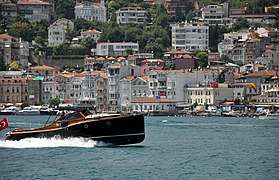
The Albanian diaspora in Africa and Asia, in such countries as Egypt, Syria or Turkey, was predominantly formed during the Ottoman period through economic migration and early years of the Republic of Turkey through migration due to sociopolitical discrimination and violence experienced by Albanians in Balkans.[204]
In Turkey, the exact numbers of the Albanian population of the country are difficult to correctly estimate. According to a 2008 report, there were approximately 1.300,000 people of Albanian descent living in Turkey.[205] As of that report, more than 500,000 Albanian descendants still recognise their ancestry and or their language, culture and traditions.[206]
There are also other estimates that range from being 3 to 4 million people up to a total of 5 million in number, although most of these are Turkish citizens of either full or partial Albanian ancestry being no longer fluent in Albanian, comparable to the German Americans.[206][207][27] This was due to various degrees of either linguistic and or cultural assimilation occurring amongst the Albanian diaspora in Turkey.[27] Albanians are active in the civic life of Turkey.[206][208]
In Egypt there are 18,000 Albanians, mostly Tosk speakers.[27] Many are descendants of the Janissaries of Muhammad Ali Pasha, an Albanian who became Wāli, and self-declared Khedive of Egypt and Sudan.[27] In addition to the dynasty that he established, a large part of the former Egyptian and Sudanese aristocracy was of Albanian origin.[27] Albanian Sunnis, Bektashis and Orthodox Christians were all represented in this diaspora, whose members at some point included major Renaissance figures (Rilindasit), including Thimi Mitko, Spiro Dine, Andon Zako Çajupi, Milo Duçi, Fan Noli and others who lived in Egypt for a time.[209] With the ascension of Gamal Abdel Nasser in Egypt and rise of Arab nationalism, the last remnants of Albanian community there were forced to leave.[210] Albanians have been present in Arab countries such as Syria, Lebanon,[209] Iraq, Jordan, and for about five centuries as a legacy of Ottoman Turkish rule.
Americas and Oceania
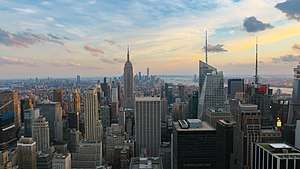
The first Albanian migration to North America began in the 19th and 20th centuries not long after gaining independence from the Ottoman Empire. However the Arbëreshë people from Southern Italy were the first Albanian people to arrive in the New World, many of them migrating after the wars that accompanied the Risorgimento.[212][213]
Since then several Albanian migration waves have occurred throughout the 20th century as for instance after the Second World War with Albanians mostly from Yugoslavia rather than from Communist Albania, then after the Breakup of Communist Albania in 1990 and finally following the Kosovo War in 1998.[214][215]
The most sizeable Albanian population in the Americas is predominantly to be found in the United States. As of 2017, there are approximately 205.000 Albanians in the country with the main concentration in the states of New York, Michigan, Massachusetts and Illinois.[216][49] The number could be higher counting the Arbëreshë people as well; they are often distinguishable from other Albanian Americans with regard to their Italianized names, nationality and a common religion.
In Canada, there are more than approximately 39.000 Albanians in the country comprising 36,185 Albanians from Albania and 2,870 Albanians from Kosovo predominantly distributed in a multitude of provinces like Ontario, Quebec, Alberta and British Columbia.[51] Canada's largest cities such as Toronto, Montreal and Edmonton were besides the United States a major centre of Albanian migration to North America.
Albanian immigration to Australia took place in the late 19th century and much of the 20th century.[218] Following the introduction of migration quotas by the United States, people who had planned to immigrate to the States were forced to choose Australia instead. The majority of them had Muslim and Orthodox backgrounds and tended to live in Victoria and Queensland but also in Western and Northern Australia.[218][219]
Italy's annexation of Albania and its alliance with Nazi Germany against the allies marked a difficult time for Albanian and Italian Australians as they were thought by Australian authorities to pose a fascist threat. However, the number of Albanian immigrants slowed consequently during that time but also due to immigration restrictions placed by the communist regime in Albania.
The most recent Albanian immigrants came mostly from Kosovo and the former Yugoslavian countries inclusively North Macedonia and Serbia and Montenegro. The immigrants were mostly Muslims but also Orthodox and Catholics among them the relatives of the renowned Albanian nun and missionary Mother Teresa.[218]
In 2016, approximately 4,041 persons resident in Australia identified themselves as having been born in Albania, while 15,901 persons identified themselves as having Albanian ancestry, either alone or in combination with another ancestry.[220] There are many Albanian Australians that were born in Italy, Macedonia as well as Kosovo, due to this they are recorded under those statistics.
Culture
Culinary arts
Cuisine
The traditional cuisine of the Albanians is diverse and has been greatly influenced by their traditions, their varied environment in the Balkans and their turbulent history throughout the course of the centuries.[223] The enjoyment of food had and has a high priority in the lives of the Albanians especially when it comes to celebrating religious festivals such as Christmas, Easter, Hanukkah, Novruz or Ramadan.
Albanian cuisine is different from region to another and each Albanian speaking territory preserves a distinctive regional cuisine characterised by local specialties and different styles within the Albanian cuisine. There is a considerable diversity between the Italian and Greek-influenced cuisines of the Arbëreshës and Chams as well as of the Mediterranean and Balkan-influenced cuisines of the Albanians in the Balkans.
Among the essential characteristics in Albanian cuisine is undoubtedly the generous use of a wide range of ingredients and spices specific to their locations. It includes many varieties of fruits such as lemons, oranges, figs and olives. Spices and other herbs such as basil, lavender, mint, oregano, rosemary and thyme are also used, as are vegetables such as garlics, onions, peppers, potatoes and tomatoes.
The Albanian diet, for those Albanians who lives closer to the sea and lakes, are able to complement their diet with fresh and saltwater fish, shellfish and other seafood specialities from the Mediterranean Sea and Ohrid Lake. Otherwise, lamb is often considered as the traditional meat for different religious festivals and poultry, beef and pork are also in plentiful supply.
In Albania, Tavë Kosi is a national dish consisting of garlicky lamb and rice baked under a thick, tart veil of yogurt. Fërgesë is another national dish and is made up with peppers, tomatoes and cottage cheese. Another beloved dish in Albania and other Albanian-speaking territories is called Pite which is generally a filled and baked pastry with a filling of a mixture of spinach and gjizë or mish. Also famous is Flia consisting of multiple crepe-like layers brushed with crea. Petulla, a traditionally fried dough, and Krofne, similar to Berliner, constitute as well a popular speciality in Albanian cuisine.
Visual arts
Painting
.jpg)
The earliest preserved relics of visual arts of the Albanian people are sacred in nature and represented by numerous frescoes, murals and icons which has been created with an admirable use of color and gold. They reveal a wealth of various influences and traditions that converged in the historical lands of the Albanian people throughout the course of the centuries.[224]
The rise of the Byzantines and Ottomans during the Middle Ages was accompanied by a corresponding growth in Christian and Islamic art in the historical lands of the Albanian people often apparent in examples of architecture and mosaics throughout Albania.[225][226] The Albanian Renaissance proved crucial to the emancipation of the modern Albanian culture and saw unprecedented developments in all fields of literature and arts whereas artists sought to return to the ideals of Impressionism and Romanticism.[227][228][228]
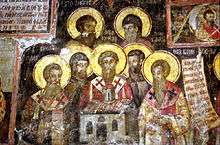
Onufri, founder of the Berat School, Kolë Idromeno, David Selenica, Kostandin Shpataraku and the Zografi Brothers are the most eminent representatives of Albanian art. Albanians in Italy and Croatia have been also active among others the Renaissance influenced artists such as Marco Basaiti, Viktor Karpaçi and Andrea Nikollë Aleksi. In Greece, Eleni Boukouras is noted as being the first great female painter of post independence Greece.
In 1856, Pjetër Marubi arrived in Shkodër and established the first photography museum in Albania and probably the first in all the Balkans, the Marubi Museum. The collection of 150.000 photographs, captured by the Albanian-Italian Marubi dynasty, offers an ensemble of photographs depicting social rituals, traditional costumes, portraits of Albanian history.
The Kulla, a traditional Albanian dwelling constructed completely from natural materialsis, is a cultural relic from the medieval period particularly widespread in the southwestern region of Kosovo and northern region of Albania. The rectangular shape of a Kulla is produced with irregular stone ashlars, river pebbles and chestnut woods however, the size and number of floors resulted in each case from the size of the family and their financial resources.
Literature
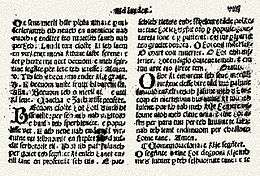
The roots of literature of the Albanian people can be traced to the Middle Ages with surviving works about history, theology and philosophy dating from the Renaissance.[229]
The earliest known use of written Albanian is a baptismal formula (1462) written by the Archbishop of Durrës Paulus Angelus.[230] In 1555, a Catholic clergyman Gjon Buzuku from the Shestan region published the earliest known book written in Albanian titled Meshari (The Missal) regarding Catholic prayers and rites containing archaic medieval language, lexemes and expressions obsolete in contemporary Albanian.[231] Other Christian clergy such as Luca Matranga in the Arbëresh diaspora published (1592) in the Tosk dialect while other notable authors were from northern Albanian lands and included Pjetër Budi, Frang Bardhi, and Pjetër Bogdani.[232]
In the 17th and onwards, important contributions to Albanian literature were made by the Arbëreshë people of Southern Italy who played an influential role in encouraging the Albanian Renaissance. Notable among them was figures such as Demetrio Camarda, Gabriele Dara, Girolamo de Rada, Giulio Variboba and Giuseppe Serembe who produced inspiring nationalist literature and worked to systematise the Albanian language.[233]
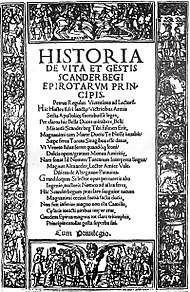
The Bejtexhinj in the 18th century emerged as the result of the influences of Islam and particularly Sufism orders moving towards Orientalism.[234] Individuals such as Nezim Frakulla, Hasan Zyko Kamberi, Shahin and Dalip Frashëri compiled literature infused with expressions, language and themes on the circumstances of the time, the insecurities of the future and their discontent at the conditions of the feudal system.[234]
The Albanian Renaissance in the 19th century is remarkable both for its valuable poetic achievement and for its variety within the Albanian literature. It drew on the ideas of Romanticism and Enlightenment characterised by its emphasis on emotion and individualism as well as the interaction between nature and mankind. Dora d'Istria, Girolamo de Rada, Naim Frashëri, Naum Veqilharxhi, Sami Frashëri and Pashko Vasa maintained this movement and are remembered today for composing series of prominent works.
The 20th century was centred on the principles of Modernism and Realism and characterised by the development to a more distinctive and expressive form of Albanian literature.[235] Pioneers of the time include Asdreni, Faik Konica, Fan Noli, Lasgush Poradeci, Migjeni who chose to portray themes of contemporary life and most notably Gjergj Fishta who created the epic masterpiece Lahuta e Malcís.[235]
Albania, post World War Two emerged as a communist state and Socialist realism became part of the literary scene.[236] Authors and poets emerged such as Sejfulla Malëshova, Dritero Agolli and Ismail Kadare who has become an internationally acclaimed novelist and others who challenged the regime through various sociopolitical and historic themes in their works.[236] Martin Camaj wrote in the diaspora while in neighbouring Yugoslavia, the emergence of Albanian cultural expression resulted in sociopolitical and poetic literature by notable authors like Adem Demaçi, Rexhep Qosja, Jusuf Buxhovi.[237] The Albanian literary scene at the beginning of the 21st century remains vibrant producing new novelists, authors, poets and other writers.[238]
Performing arts
Apparel
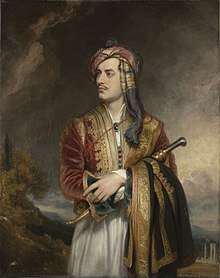
The Albanian people have incorporated various natural materials from their local agriculture and livestock as a vital source for attire, clothing and fabrics. Their traditional apparel was primarily influenced by nature, the way of life and has been continuously changed since ancient times.[239] Each of the Albanian regions possesses their own exceptional clothing traditions and peculiarities varied occasionally in colour, material and shape.
The traditional costume of Albanian men includes a white skirt garment called Fustanella, a white shirt with wide sleeves, and a thin black jacket or vest, such as the Xhamadan or Xhurdia. In winter, they add a warm woolen coat or fur coat known as Flokata or Dollama made from sheepskin or goat fur. Another authentic piece is called Tirq which is a tight pair of felt trousers mostly white, sometimes dark brown or black.
The Albanian women's costumes are much more complicated, more colorful, richer in ornamentation and elaborate than that costume of the Albanian men. In all the Albanian regions the women's clothing often has been decorated with filigree ironwork, colorful embroidery, a lot of symbols and vivid accessories. A unique and ancient dress is called Xhubleta, a bell shaped skirt reaching down to the calves and worn from the shoulders with two shoulder straps at the upper part.[240][241]
The traditional Albanian headdresses remain a contrasting and recognisable feature of Albanian traditional clothing. Albanian men traditionally wore hats of various designs, shape and size. A very common headgear is a Plis and Qylafë, in contrast, Albanian women wore a Kapica adorned with jewels or embroidery on the forehead, and a Lëvere or Kryqe which usually covers the head, shoulders and neck. Wealthy Albanian women wore headdresses embellished with gems, gold or silver.
Different traditional handmade shoes and socks were worn by the Albanian people. The leather shoes called Opinga were made from rough animal skin and worn with knitted woolen socks known as Çorape worked either in wool or cotton.
Music

For the Albanian people, music is a vital component to their culture and characterised by its own peculiar features and diverse melodic pattern reflecting the history, language and way of life.[242] It rather varies from region to another with two essential stylistic differences between the music of the Ghegs and Tosks. Hence, their geographic position in Southeast Europe in combination with cultural, political and social issues is frequently expressed through music along with the accompanying instruments and dances.
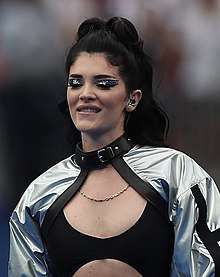
Albanian folk music is contrasted by the heroic tone of the Ghegs and the relaxed sounds of the Tosks.[243] Traditional iso-polyphony perhaps represents the most noble and essential genre of the Tosks which was proclaimed a Masterpiece of the Intangible Heritage of Humanity by UNESCO.[244] Ghegs in contrast have a reputation for a distinctive variety of sung epic poetry often about the tumultuous history of the Albanian people.
There are a number of international acclaimed singers of Albanian origin across the world such as Action Bronson, Ava Max, Bebe Rexha, Dua Lipa, Era Istrefi, Gashi and Rita Ora.
In international competitions, Albania participated in the Eurovision Song Contest for the first time in 2004. Albanians have also represented other countries in the contest as for instance Anna Oxa for Italy in 1989, Adrian Gaxha for Macedonia in 2008 as well as Ermal Meta for Italy in 2018. Kosovo has never participated but is currently applying to become a member of the EBU and therefore debut in the contest.
Religion
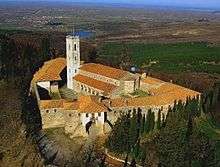
Many different spiritual traditions, religious faiths and beliefs are practised by the Albanian people who historically have succeeded to coexist peacefully over the centuries in Southeast Europe. They are traditionally both Christians and Muslims, Catholics and Orthodox, Bektashis and Sunnis but also to a lesser extant Evangelists, Protestants and Jews, perhaps constituting the most religiously diverse people of Europe.[245]
In the medieval era, prior to the arrival of Islam into the Albanian inhabited lands, Christianity was the predominant religion among the Albanians. They were mostly following Orthodox traditions and practices until the middle of the 13th century as Gheg Albanians began to convert to Catholicism as a mean to resist the oppression of the Slavs.[lower-alpha 8] During the Ottoman conquest of the Balkans, Christianity began to be overtaken by Islam, and Catholicism and Orthodoxy continued to be practiced with less frequency.
During the modern era, the monarchy and communism in Albania as well as the socialism in Kosovo, historically part of Yugoslavia, followed a systematic secularisation of its people. This policy was chiefly applied within the borders of both territories and produced a secular majority of its population.
All forms of Christianity, Islam and other religious practices were prohibited except for old non-institutional pagan practices in the rural areas, which were seen as identifying with the national culture. The current Albanian state has revived some pagan festivals, such as the Spring festival (Albanian: Dita e Verës) held yearly on 14 March in the city of Elbasan. It is a national holiday.[247]
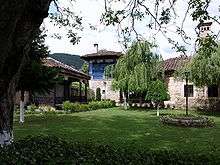
The communist regime which ruled Albania after World War II persecuted and suppressed religious observance and institutions, and entirely banned religion to the point where Albania was officially declared to be the world's first atheist state. Religious freedom returned to Albania following the regime's change in 1992. Albanian Sunni Muslims are found throughout the country, Albanian Orthodox Christians as well as Bektashis are concentrated in the south, while Roman Catholics are found primarily in the north of the country.[248]
In Albania, 58.79% of the population adheres to Islam, making it the largest religion in the country. Christianity is practiced by 16.99% of the population, making it the second largest religion in the country. The remaining population is either irreligious or belongs to other religious groups.[249] Before World War II, there was given a distribution of 70% Muslims, 20% Eastern Orthodox, and 10% Roman Catholics.[250] Today, Gallup Global Reports 2010 shows that religion plays a role in the lives of only 39% of Albanians, and ranks Albania the thirteenth least religious country in the world.[251]
For part of its history, Albania has also had a Jewish community. Members of the Jewish community were saved by a group of Albanians during the Nazi occupation.[252] Many left for Israel c. 1990–1992 when the borders were opened after the fall of the communist regime, but about 200 Jews still live in Albania.
| Religion | |||||||
|---|---|---|---|---|---|---|---|
| Islam | 21%[255] to 82%[256] | 88.8 to 95.60[257] | 98.62[257] | 73.15 | 71.06 | 54.78 | 41.49 |
| Sunni | 56.70 | — | — | — | — | — | — |
| Bektashi | 2.09 to 7.5[258] | — | — | — | - | — | - |
| Christians | 9[255] to 28.64[258] | 3.69 to 6.20[257] | 1.37 | 26.37 | 19.54 | 40.69 | 38.85 |
| Catholic | 3%[255] to 13.82[258] | 2.20 to 5.80[257] | 1.37 | 26.13 | 16.84 | 40.59 | 27.67 |
| Orthodox | 6[255] to 13.08[258] | 1.48 | — | 0.12 | 2.60 | 0.01 | 11.02 |
| Protestants | 0.14 to 1.74[258] | 0.16 | — | - | 0.03 | — | — |
| Other Christians | 0.07 | — | — | 0.12 | 0.07 | 0.09 | — |
| Unaffiliated or Irreligious | 24.21% to 62.7%[259] | ||||||
| Atheist | 2.50% to 9%[260] | 0.07 to 2.9[257] | — | 0.11 | 2.95 | 1.80 | 17.81 |
| Prefer to not answer | 1%[258] to 13.79% | 0.55 | 0.19 | 2.36 | 1.58 | — | — |
| Agnostic | 5.58[259] | 0.02 | |||||
| Believers without denomination | 5.49 | — | — | — | — | — | |
| Not relevant/not stated | 2.43 | 0.06 | 0.16 | 0.36 | 4.82 | — | |
| Other religion | 1.19[258] | 0.03 | 1.85 |
See also
- List of Albanians
- History of Albania
- Culture of Albania
- Geography of Albania
Notes
- Sunni Islam is the largest denomination of the Albanian people in Albania, Kosovo, Montenegro and North Macedonia.
- Catholicism (roman-latin and greek-byzantine rite) is the largest Christian denomination of the Albanian people in northern Albania, Croatia, Italy and south Albania with the byzantine rite, Kosovo and Montenegro.
- Eastern Orthodoxy is the largest Christian denomination of the Albanian people in southern Albania, North Macedonia and Greece.
- Kosovo is the subject of a territorial dispute between the Republic of Kosovo and the Republic of Serbia. The Republic of Kosovo unilaterally declared independence on 17 February 2008, but Serbia continues to claim it as part of its own sovereign territory. The two governments began to normalise relations in 2013, as part of the 2013 Brussels Agreement. Kosovo is currently recognized as an independent state by 97 out of the 193 United Nations member states. In total, 112 UN member states recognized Kosovo at some point, of which 15 later withdrew their recognition.
- See:[64][65][66][67]
- See:[67][68][69][70][71][72]
- See:[70][87][88][89][90][91]
- See:[246][75][76][77]
- Widely fluctuating numbers for groups in Albania are due to various overlapping definitions based on how groups can be defined, as religion can be defined in Albania either by family background, belief or practice
Sources
- Anscombe, Frederick (2006). "Albanians and "mountain bandits"". In Anscombe, Frederick (ed.). The Ottoman Balkans, 1750–1830. Princeton: Markus Wiener Publishers. pp. 87–113. ISBN 9781558763838. Archived from the original on 25 January 2016.CS1 maint: ref=harv (link)
- Anscombe, Frederick (2006b). "The Ottoman Empire in Recent International Politics – II: The Case of Kosovo". The International History Review. 28 (4): 758–793. doi:10.1080/07075332.2006.9641103. JSTOR 40109813.CS1 maint: ref=harv (link)
- Belledi, Michele; Poloni, Estella S.; Casalotti, Rosa; Conterio, Franco; Mikerezi, Ilia; Tagliavini, James; Excoffier, Laurent (2000). "Maternal and paternal lineages in Albania and the genetic structure of Indo-European populations". European Journal of Human Genetics. 8 (7): 480–486. doi:10.1038/sj.ejhg.5200443. PMID 10909846.CS1 maint: ref=harv (link)
- Barančić, Maximilijana (2008). "Arbanasi i etnojezični identitet Arbanasi and ethnolinguistic identity". Croatica et Slavica Iadertina. 4 (4): 551–568.CS1 maint: ref=harv (link)
- Bintliff, John (2003). "The Ethnoarchaeology of a "Passive" Ethnicity: The Arvanites of Central Greece" (PDF). In Brown, K.S.; Hamilakis, Yannis (eds.). The Usable Past: Greek Metahistories. Lanham: Lexington Books. pp. 129–144. ISBN 9780739103845.CS1 maint: ref=harv (link)
- Bonnefoy, Yves (1993). American, African, and old European mythologies. Chicago: University of Chicago Press. ISBN 9780226064574.CS1 maint: ref=harv (link)
- Demiraj, Bardhyl (2010). "Shqiptar–The generalization of this ethnic name in the XVIII century". In Demiraj, Bardhyl (ed.). Wir sind die Deinen: Studien zur albanischen Sprache, Literatur und Kulturgeschichte, dem Gedenken an Martin Camaj (1925–1992) gewidmet [We are his people: Studies on the Albanian language, literature and cultural history, dedicated to the memory of Martin Camaj (1925–1992)]. Wiesbaden: Otto Harrassowitz Verlag. pp. 533–565. ISBN 9783447062213.CS1 maint: ref=harv (link)
- Demiraj, Shaban (1998). "Albanian". In Ramat, Anna Giacalone; Ramat, Paolo (eds.). The Indo-European languages. London: Routledge. pp. 480–501. ISBN 9780415064491.CS1 maint: ref=harv (link)
- Ducellier, Alain (1995). "Albania, Serbia and Bulgaria". In Abulafia, David; McKitterick, Rosamond (eds.). The New Cambridge Medieval History: Volume 5, C.1198-c.1300. Cambridge: Cambridge University Press. pp. 779–795. ISBN 9780521362894.CS1 maint: ref=harv (link)
- Eliade, Mircea; Adams, Charles J. (1987). The Encyclopedia of religion, Volume 1. New York: Macmillan. ISBN 9780029094808.CS1 maint: ref=harv (link)
- Elsie, Robert (2003). Early Albania: A reader of Historical texts, 11th–17th centuries. Wiesbaden: Otto Harrassowitz Verlag. ISBN 9783447047838.CS1 maint: ref=harv (link)
- Elsie, Robert (2005). Albanian literature: A short history. London: I.B. Tauris. ISBN 9781845110314.CS1 maint: ref=harv (link)
- Elsie, Robert (2010). Historical Dictionary of Albania. Lanham: Scarecrow Press. ISBN 9780810873803.CS1 maint: ref=harv (link)
- Finlay, George (1851). The History of Greece: From Its Conquest by the Crusaders to Its Conquest by the Turks, and of the Empire of Trebizond: 1204–1461. London: Blackwood.CS1 maint: ref=harv (link)
- Frazee, Charles (2006). Catholics and Sultans: The Church and the Ottoman Empire 1453–1923. Cambridge: Cambridge University Press. ISBN 9780521027007.CS1 maint: ref=harv (link)
- Geniş, Şerife; Maynard, Kelly Lynne (2009). "Formation of a Diasporic Community: The history of migration and resettlement of Muslim Albanians in the Black Sea Region of Turkey". Middle Eastern Studies. 45 (4): 553–569. doi:10.1080/00263200903009619.CS1 maint: ref=harv (link)
- Giakoumis, Konstantinos (2010). "The Orthodox Church in Albania Under the Ottoman Rule 15th–19th Century". In Schmitt, Oliver Jens (ed.). Religion und Kultur im albanischsprachigen Südosteuropa [Religion and culture in Albanian-speaking southeastern Europe]. Frankfurt am Main: Peter Lang. pp. 69–110. ISBN 9783631602959.CS1 maint: ref=harv (link)
- Gogonas, Nikos (2010). Bilingualism and multiculturalism in Greek education: Investigating ethnic language maintenance among pupils of Albanian and Egyptian origin in Athens. Cambridge Scholars Publishing. ISBN 9781443822145.CS1 maint: ref=harv (link)
- Groenendijk, Kees (2006). Bauböck, Rainer; Ersbøll, Eva; Groenendijk, Kees; Waldrauch, Harald (eds.). Acquisition and Loss of Nationality: Comparative Analyses – Policies and Trends in 15 European Countries. Amsterdam: Amsterdam University Press. pp. 411–430. ISBN 9789053569207.CS1 maint: ref=harv (link)
- Hall, Jonathan (1997). Ethnic Identity in Greek antiquity. Cambridge: Cambridge University Press. ISBN 9780521789998.CS1 maint: ref=harv (link)
- Hock, Hans Henrich; Joseph, Brian D. (1996). Language history, language change, and language relationship: An introduction to historical and comparative linguistics. Berlin: Mouton de Gruyter. ISBN 9783110147841.CS1 maint: ref=harv (link)
- Jagodić, Miloš (1998). "The Emigration of Muslims from the New Serbian Regions 1877/1878". Balkanologie. 2 (2).CS1 maint: ref=harv (link)
- Jelavich, Barbara (1983). History of the Balkans. Cambridge: Cambridge University Press. ISBN 9780521274593.
Albanoi.
CS1 maint: ref=harv (link) - Kamusella, Tomasz (2009). The politics of language and nationalism in modern Central Europe. Basingstoke: Palgrave Macmillan. ISBN 9780230550704.CS1 maint: ref=harv (link)
- Kolovos, Elias (2007). The Ottoman Empire, the Balkans, the Greek lands: Toward a social and economic history: Studies in honor of John C. Alexander. Istanbul: Isis Press. ISBN 9789754283464.CS1 maint: ref=harv (link)
- Koti, Dhori (2010). Monografi për Vithkuqin dhe Naum Veqilharxhin [A monograph of Vithkuq and Naum Veqilharxhi]. Pogradec: DIJA Poradeci. ISBN 978-99956-826-8-2.CS1 maint: ref=harv (link)
- Koukoudis, Asterios (2003). The Vlachs: Metropolis and Diaspora. Thessaloniki: Zitros Publications. ISBN 9789607760869.CS1 maint: ref=harv (link)
- Liakos, Antonis (2012). "Hellenism and the making of Modern Greece: Time, Language, Space". In Zacharia, Katerina (ed.). Hellenisms: culture, identity, and ethnicity from antiquity to modernity. Aldershot: Martinus Nijhoff Publishers. pp. 201–236. ISBN 9789004221529.CS1 maint: ref=harv (link)
- Liotta, Peter H. (2001). Dismembering the state: The death of Yugoslavia and why it matters. Lanham: Lexington Books. ISBN 9780739102121.CS1 maint: ref=harv (link)
- Lloshi, Xhevat (1999). "Albanian". In Hinrichs, Uwe; Büttner, Uwe (eds.). Handbuch der Südosteuropa-Linguistik. Wiesbaden: Otto Harrassowitz Verlag. pp. 272–299. ISBN 9783447039390.CS1 maint: ref=harv (link)
- Madgearu, Alexandru; Gordon, Martin (2008). The wars of the Balkan Peninsula: Their medieval origins. Lanham: Scarecrow Press. p. 43. ISBN 9780810858466.
Albanoi.
CS1 maint: ref=harv (link) - Malcolm, Noel (1998). Kosovo: A short history. London: Macmillan. ISBN 9780333666128.CS1 maint: ref=harv (link)
- Mëniku, Linda; Campos, Héctor (2012). Colloquial Albanian: The complete course for beginners. London: Routledge. ISBN 9781317306818.CS1 maint: ref=harv (link)
- Murati, Qemal (1991). Konservacione dhe inovacione gjuhësore në fushë të shqipes [Conservation and innovations in the field of Albanian language]. Flaka e Vëllazërimit.CS1 maint: ref=harv (link)
- Nasse, George Nicholas (1964). The Italo-Albanian Villages of Southern Italy. Washington, District of Columbia: National Academy of Sciences-National Research Council.CS1 maint: ref=harv (link)
- Nicol, Donald MacGillivray (1986). Studies in late Byzantine history and prosopography. Variorum Reprints. ISBN 9780860781905.CS1 maint: ref=harv (link)
- Norris, Harry Thirlwall (1993). Islam in the Balkans: religion and society between Europe and the Arab world. Columbia: University of South Carolina Press. p. 249. ISBN 9780872499775.
Albanians Arnaout Syria.
CS1 maint: ref=harv (link) - Novik, Alexander Alexandrovich (2015). "Lexicon of Albanian mythology: Areal studies in the polylingual region of Azov Sea". Slavia Meridionalis. 15: 261–273. doi:10.11649/sm.2015.022.CS1 maint: ref=harv (link)
- Pappas, Nicholas CJ. (2008). "Stradioti: Balkan Mercenaries in Fifteenth and Sixteenth Century Italy". Sam Houston State University. Archived from the original on 24 September 2015. Retrieved 26 November 2016.
- Pritsak, Omeljan (1991). "Albanians". In Kazhdan, Alexander P. (ed.). Oxford Dictionary of Byzantium. Oxford: Oxford University Press. ISBN 9780195046526. OCLC 311413460.CS1 maint: ref=harv (link)
- Ragionieri, Rodolfo (2008). "Mediterranean Geopolitics". In Petricioli, Marta (ed.). L'Europe Méditerranéenne [Mediterranean Europe]. Berlin: Peter Lang. pp. 37–48. ISBN 9789052013541.CS1 maint: ref=harv (link)
- Ramet, Sabrina P. (1989). Religion and nationalism in Soviet and East European politics. Durham: Duke University Press. ISBN 9780822308911.CS1 maint: ref=harv (link)
- Ramet, Sabrina (1998). Nihil obstat: religion, politics, and social change in East-Central Europe and Russia. Durham: Duke University Press. ISBN 9780822320708.CS1 maint: ref=harv (link)
- Riehl, Claudia Maria (2010). "Discontinious language spaces (Sprachinseln)". In Auer, Peter; Schmidt, Jürgen Erich (eds.). Language and Space: An International Handbook of Linguistic Variation. Theories and Methods. Berlin: Walter de Gruyter. pp. 332–354. ISBN 9783110220278.CS1 maint: ref=harv (link)
- Sarner, Harvey (1997). Rescue in Albania: One Hundred Percent of Jews in Albania Rescued from Holocaust. Cathedral City: Brunswick Press. ISBN 9781888521115. Archived from the original on 10 May 2008.CS1 maint: ref=harv (link)
- Saunders, Robert A. (2011). Ethnopolitics in Cyberspace: The Internet, Minority Nationalism, and the Web of Identity. Lanham: Lexington Books. ISBN 9780739141946.CS1 maint: ref=harv (link)
- Skendi, Stavro (1956). "Religion in Albania during the Ottoman rule". Südost Forschungen. 15: 311–327.CS1 maint: ref=harv (link)←
- Stavrianos, Leften Stavros (2000). The Balkans Since 1453. C. Hurst & Co. Publishers. ISBN 9781850655510.CS1 maint: ref=harv (link)
- Uka, Sabit (2004d). E drejta mbi vatrat dhe pasuritë reale dhe autoktone nuk vjetërohet: Të dhëna në formë rezimeje [The rights of homes and assets, real and autochthonous that does not disappear with time: Data given in the form of estate portions regarding inheritance]. Prishtina: Shoqata e Muhaxhirëvë të Kosovës. ISBN 9789951408097.CS1 maint: ref=harv (link)
- Vasiliev, Alexander A. (1958). History of the Byzantine Empire, 324–1453. Madison: University of Wisconsin Press. ISBN 978-0-299-80926-3.CS1 maint: ref=harv (link)
- Veremis, Thanos; Kolipoulos, John (2003). "The evolving Content of the Greek Nation". In Couloumbis, Theodore A.; Kariotis, Theodore C.; Bello, Fotini (eds.). Greece in the twentieth century. Portland: Psychology Press. ISBN 9781136346521.CS1 maint: ref=harv (link)
- Vickers, Miranda (2011). The Albanians: a modern history. London: IB Tauris. ISBN 9780857736550.CS1 maint: ref=harv (link)
- Matzinger, Joachim (2013). "Shqip bei den altalbanischen Autoren vom 16. bis zum frühen 18. Jahrhundert [Shqip within Old Albanian authors from the 16th to the early 18th century]". Zeitschrift für Balkanologie. Retrieved 31 October 2015.
- Durham, Edith (1905). The Burden of the Balkans. peacelink.nu. Retrieved 3 October 2014.
References
- Carl Skutsch, Encyclopedia of the World's Minorities, Routledge, 2013 ISBN 1135193886, p. 65.
- Steven L. Danver, Native Peoples of the World: An Encyclopedia of Groups, Cultures and Contemporary Issues:, Routledge, 2015, ISBN 1317463994, p. 260.
- Mary Rose Bonk. Worldmark Yearbook, Band 1. Gale Group, 2000. p. 37.
- National Geographic, Band 197 (University of Michigan ed.). National Geographic Society, 2000. 2000. p. 59.
- Over 20 Peace Corps Language Training Publications – Country Pre-departure Materials. Jeffrey Frank Jones.
- "Albania". cia.gov.
- "Kosovo". cia.gov.
- "Total Population of Albanians in the Sweden". Ethnologue.
- "Albanians in the UK" (PDF). unitedkingdom. Archived from the original (PDF) on 14 October 2015. Retrieved 10 February 2020.
- "05183: Immigrants and Norwegian-born to immigrant parents, by sex and country background". ssb.no. Statistisk Sentralbyrå.
- "Population by language on 31 December". stat.fi. Statistics Finland. 29 December 2018.
- "Demographics of Finland".
- "National statistics of Denmark". Dst.dk. Archived from the original on 26 September 2010. Retrieved 22 September 2010.
- "Census of Population 2016 – Profile 7 Migration and Diversity All non-Irish nationals in Ireland". cso.ie. Central Statistics Office.
- "Population Usually Resident and Present in the State who Speak a Language other than English or Irish at Home 2011 to 2016 by Birthplace, Language Spoken, Age Group and Census Year". cso.ie. Central Statistics Office.
- "Date demografice" (in Romanian). Archived from the original on 11 August 2010. Retrieved 18 August 2010.
- Olson, James S., An Ethnohistorical Dictionary of the Russian and Soviet Empires. (Westport: Greenwood Press, 1994) p. 28–29
- "T14 Cizinci podle kategorií pobytu, pohlaví a občanství k 31. 12. 2016". czso.cz (in Slovak and English). Český statistický úřad.
- "Latvijas iedzīvotāju sadalījums pēc nacionālā sastāva un valstiskās piederības" (PDF). pmlp.gov.lv (in Latvian).
- Managing Migration: The Promise of Cooperation. By Philip L. Martin, Susan Forbes Martin, Patrick Weil
- "Announcement of the demographic and social characteristics of the Resident Population of Greece according to the 2011 Population – Housing Census" [Graph 7 Resident population with foreign citizenship] (PDF). Greek National Statistics Agency. 23 August 2013. Archived from the original (PDF) on 25 December 2013. Retrieved 3 June 2014.
- Groenendijk 2006, p. 416. "approximately 200,000 of these immigrants have been granted the status of homogeneis".
- "Kosovari in Italia – statistiche e distribuzione per regione". Tuttitalia.it.
- "Arbëreshiski language of Italy – Ethnic population: 260,000 (Stephens 1976)". Ethnologue.
- "Cittadini non-comunitari regolarmente presenti". istat.it. 4 August 2014. Archived from the original on 13 November 2014. Retrieved 3 October 2014.
- "Albanians in Turkey celebrate their cultural heritage". Today's Zaman. 21 August 2011. Archived from the original on 31 October 2015. Retrieved 4 November 2015.
- Saunders 2011, p. 98. "In addition to the recent emigrants, there are older diasporic communities around the world. There are upwards of 5 million ethnic Albanians in the Turkish Republic; however, the vast majority of this population is assimilated and no longer possesses fluency in the language, though a vibrant Albanian community maintains its distinct identity in Istanbul to this day. Egypt also lays claim to some 18,000 Albanians, supposedly lingering remnants of Mohammad Ali's army."
- Yenigun, Cuneyt (2009). "GCC Model: Conflict Management for the "Greater Albania"" (PDF). SDU Faculty of Arts and Sciences Journal of Social Sciences. 2: 175–185. Archived from the original (PDF) on 27 September 2015.CS1 maint: ref=harv (link). Page 184: "Turkey contains 5–6 million Albanians (more than in the Balkan area)"
- "Census of Population, Households and Dwellings in the Republic of Macedonia, 2002 final data" (PDF). stat.gov.mk (in English and Macedonian). State Statistical Office of the Republic of Macedonia. p. 591.
- "Census of Population, Households and Dwellings in the Republic of Macedonia, 2002 final data" (PDF). stat.gov.mk (in English and Macedonian). State Statistical Office of the Republic of Macedonia. p. 62.
- "Official Results of Monenegrin Census 2011" (PDF). Statistical Office of Montenegro. n.d. Retrieved 24 December 2013.
- "Population by Ethnicity, by Towns/Municipalities, 2011 Census". Census of Population, Households and Dwellings 2011. Zagreb: Croatian Bureau of Statistics. December 2012.
- "7. Prebivalstvo po narodni pripadnosti, Slovenija, popisi 1953, 1961, 1971, 1981, 1991 in 2002". stat.si (in Slovenian).
- "Попис становништва , домаћинстава и станова 2011. у Републици Србији" (PDF). webrzs.stat.gov.rs (in Serbian). Statistical Office of the Republic of Serbia. p. 9. Archived from the original (PDF) on 8 July 2018.
- "Población y edad media por nacionalidad y sexo". ine.es (in Spanish). Instituto Nacional de Estadística.
- "Population – Country of Birth, Citizenship Category, Country of Citizenship, Language, Religion, Ethnic/Religious Group, 2011". cystat.gov.cy. Statistical Service of Cyprus.
- "POPULAÇÃO ESTRANGEIRA RESIDENTE EM TERRITÓRIO NACIONAL – 2014" (PDF). sefstat.sef.pt (in Portuguese). Serviço de Estrangeiros e Fronteiras.
- Hans-Peter Bartels: Deutscher Bundestag – 16. Wahlperiode – 166. Sitzung. Berlin, Donnerstag, den 5. Juni 2008 Archived 3 January 2013 at the Wayback Machine
- Statistisches Bundesamt (2016). "Ausländische Bevölkerung Ergebnisse des Ausländerzentralregisters" (PDF). destatis.de (in German). pp. 47–50.
- Statistisches Bundesamt. "Bevölkerung, Familien, Lebensformen" (PDF). destatis.de (in German). p. 25.
- "Die Albaner in der Schweiz: Geschichtliches – Albaner in der Schweiz seit 1431" (PDF). Archived from the original (PDF) on 7 July 2011. Retrieved 22 September 2010.
- "Im Namen aller Albaner eine Moschee?". Infowilplus.ch. 25 May 2007. Archived from the original on 6 July 2011. Retrieved 22 September 2010.
- "Statistik Austria". Statistik.at. Archived from the original on 13 November 2010. Retrieved 24 December 2013.
- "Étrangers – Immigrés: Publications et statistiques pour la France ou les régions" (in French). Insee.fr. n.d. Retrieved 4 November 2015.
- "Population par nationalité, sexe, groupe et classe d'âges au 1er janvier 2010" (in French). Archived from the original on 22 December 2011. Retrieved 12 January 2012.
- "Anderlecht, Molenbeek, Schaarbeek: repères du crime à Bruxelles". cafebabel.com. Archived from the original on 26 December 2011. Retrieved 12 January 2012.
- "Bevolking; generatie, geslacht, leeftijd en migratieachtergrond, 1 januari". statline.cbs.nl (in Dutch). Centraal Bureau voor de Statistiek.
- Statistiques du Luxembourg. "Population by nationalites in detail 2011 – 2018". statistiques.public.lu.
- "TOTAL ANCESTRY REPORTED Universe: Total ancestry categories tallied for people with one or more ancestry categories reported 2013 American Community Survey 1-Year Estimates". factfinder.census.gov. United States Census Bureau (USCB). Archived from the original (Table) on 12 February 2020. Retrieved 9 November 2018.
- "Archived copy" (PDF). Archived from the original (PDF) on 16 September 2016. Retrieved 9 July 2016.CS1 maint: archived copy as title (link)
- "Ethnic Origin (279), Single and Multiple Ethnic Origin Responses (3), Generation Status (4), Age (12) and Sex (3) for the Population in Private Households of Canada, Provinces and Territories, Census Metropolitan Areas and Census Agglomerations, 2016 Census". Statistics Canada.
- "Colombia – Inmigración 1990, 1995, 2005, 2010, 2015, 2017". Expansión (in Spanish).
- "Cuba – International immigration". countryeconomy.com.
- "Población nacida en el extranjero en la República, por grupos de edad, según sexo y país de nacimiento". contraloria.gob.pa (in Spanish). National Institute of Statistics and Census of Panama.
- "20680-Ancestry (full classification list) by Sex – Australia" (Microsoft Excel download). 2006 Census. Australian Bureau of Statistics. Retrieved 2 June 2008. Total responses: 25,451,383 for total count of persons: 19,855,288.
- "2013 Census ethnic group profiles: Albanian". m.stats.govt.nz. Statistics New Zealand.
- "Qatar: Some estimates of foreign residents in Qatar by country of citizenship (selected countries, c. 2015–2016)". gulfmigration.org.
- "UAE's population – by nationality". bqdoha.com. 6 January 2019. Archived from the original on 11 July 2015.
- "Sube el número de inmigrantes que viven en Sudáfrica". Expansión (in Spanish).
- Ethnobotany in the New Europe: People, Health and Wild Plant Resources, vol. 14, Manuel Pardo de Santayana, Andrea Pieroni, Rajindra K. Puri, Berghahn Books, 2010, ISBN 1845458141, p. 18.
- Gëzim Krasniqi. "Citizenship in an emigrant nation-state: the case of Albania" (PDF). University of Edinburgh. pp. 9–14. Archived from the original (PDF) on 2 June 2013. Retrieved 7 August 2012.
- Robert Elsie (2003). Early Albania: A Reader of Historical Texts, 11th–17th Centuries. Otto Harrassowitz Verlag, 2003. pp. 4–5. ISBN 9783447047838.
- "Albaner (Name und Ethnogenese)" (PDF). research.uni-leipzig.de (in German). pp. 1–2.
- Riehl 2010, p. 238. "Other interesting groups in the context of European migration include the Albanians who from the thirteenth century immigrated to Greece (i.e., the so-called "Arvanites", see Sasse 1998) and to Southern Italy (Calabria, Sicily, cf Breu 2005)."
- Nasse 1964, pp. 24–26.
- Gogonas 2010, p. 3. "Arvanites originate from Albanian settlers who moved south at different times between the 14th and the 16th centuries from areas in what is today southern Albania The reasons for this migration are not entirely clear and may be manifold. In many instances the Arvanites were invited by the Byzantine and Latin rulers of the time. They were employed to resettle areas that had been largely depopulated through wars, epidemics and other reasons, and they were employed as soldiers. Some later movements are also believed to have been motivated to evade Islamisation after the Ottoman conquest. The main waves of the Arvanite migration into southern Greece started around 1300, reached a peak some time during the 14th century, and ended around 1600. Arvanites first reached Thessaly, then Attica and finally the Peloponnese (Clogg. 2002). Regarding the number of Arvanites in Greece, the 1951 census (the last census in Greece that included a question about language) gives a figure of 23.000 Arvaiithka speakers. Sociohinguistic research in the 1970s in the villages of Attica and Biotia alone indicated a figure of at least 30.000 speakers (Trudgill and Tzavaras 1977), while Lunden (1993) suggests 50.000 for Greece as a whole."
- Hall 1997, pp. 28–29. "The permeability of ethnic boundaries is also demonstrated in many of the Greek villages of Attiki and Viotia (ancient Attika and Boiotia), where Arvanites often form a majority) These Arvanites are descended from Albanians who first entered Greece between the eleventh and fifteenth centuries (though there was a subsequent wave of immigration in the second half of the eighteenth century). Although still regarded as ethnically distinct in the nineteenth century, their participation in the Greek War of Independence and the Civil War has led to increasing assimilation: in a survey conducted in the 1970s, 97 per crnt of Arvanite informants despite regularly speaking in Arvanitika, considered themselves to be Greek. A similar concern with being identified as Greek is exhibited by the bilingual Arvanites of the Eastern Argolid."
- Bintliff 2003, pp. 137–138. "First, we can explain the astonishing persistence of Albanian village culture from the fourteenth to the nineteenth centuries through the ethnic and religious tolerance characteristic of Islamic empires and so lacking in their Christian equivalents. Ottoman control rested upon allowing local communities to keep their religion, language, local laws, and representatives, provided that taxes were paid (the millet system). There was no pressure for Greeks and Albanians to conform to each other's language or other behavior. Clear signs of change are revealed in the travel diaries of the German scholar Ludwig Ross (1851), when he accompanied the Bavarian Otto, whom the Allies had foisted as king upon the newly freed Greek nation in the aftermath of the War of Independence in the 1830s. Ross praises the well-built Greek villages of central Greece with their healthy, happy, dancing inhabitants, and contrasts them specifically with the hovels and sickly inhabitants of Albanian villages. In fact, recent scholarship has underlined how far it was the West that built modem Greece in its own fanciful image as the land of a long-oppressed people who were the direct descendants of Pericles. Thus from the late nineteenth century onward the children of the inhabitants of the new "nation-state" were taught in Greek, history confined itself to the episodes of pure Greekness, and the tolerant Ottoman attitude to cultural diversity yielded to a deliberate policy of total Hellenization of the populace—effective enough to fool the casual observer. One is rather amazed at the persistence today of such dual-speaking populations in much of the Albanian colonization zone. However, apart from the provinciality of this essentially agricultural province, a high rate of illiteracy until well into this century has also helped to preserve Arvanitika in the Boeotian villagers (Meijs 1993)."; p. 140. "In contrast therefore to the more openly problematic issue of Slav speakers in northern Greece, Arvanitic speakers in central Greece lack any signs of an assertive ethnicity. I would like to suggest that they possess what we might term a passive ethnicity. As a result of a number of historical factors, much of the rural population in central Greece was Albanian-speaking by the time of the creation of the modern Greek state in the 1830s. Until this century, most of these people were illiterate and unschooled, yet there existed sufficient knowledge of Greek to communicate with officials and townspeople, itinerant traders, and so on, to limit the need to transform rural language usage. Life was extremely provincial, with just one major carriage-road passing through the center of the large province of Boeotia even in the 1930s (beyond which horseback and cart took over; van Effenterre 1989). Even in the 1960s, Arvanitic village children could be figures of fun for their Greek peers in the schools of Thebes (One of the two regional towns) (K. Sarri, personal communication, 2000). It was not a matter of cultural resistance but simple conservatism and provinciality, the extreme narrowness of rural life, that allowed Arvanitic language and local historic memories to survive so effectively to the very recent period."
- Liakos 2012, p. 230. "The term "Arvanite" is the medieval equivalent of "Albanian." it is retained today for the descendants of the Albanian tribes that migrated to the Greek lands during a period covering two centuries, from the thirteenth to the fifteenth."
- Liotta 2001, p. 198. "Among Greeks, the term "Alvanitis"—or "Arvanitis"—means a Christian of Albanian ancestry, one who speaks both Greek and Albanian, but possesses Greek "consciousness." Numerous "Arvanites" live in Greece today, although the ability to speak both languages is shrinking as the differences (due to technology and information access and vastly different economic bases) between Greece and Albania increase. The Greek communities of Elefsis, Marousi, Koropi, Keratea, and Markopoulo (all in the Attikan peninsula) once held significant Arvanite communities. "Arvanitis" is not necessarily a pejorative term; a recent Pan Hellenic socialist foreign minister spoke both Albanian and Greek (but not English). A former Greek foreign minister, Theodoros Pangalos, was an "Arvanite" from Elefsis."
- Pappas. para. 28. "While the bulk of stradioti rank and file were of Albanian origin from Greece, by the middle of the 16th century there is evidence that many had become Hellenized or even Italianized... Hellenization was perhaps well on its way prior to service abroad, since Albanian stradioti had settled in Greek lands for two generations prior to their emigration to Italy. Since many served under Greek commanders and served together with Greek stradioti, the process continued. Another factor in this assimilative process was the stradioti's and their families' active involvement and affiliation with the Greek Orthodox or Uniate Church communities in Naples, Venice and elsewhere. Hellenization thus occurred as a result of common service and church affiliation."
- Veremis & Kolipoulos 2003, pp. 24–25. "For the time being, the Greeks of free Greece could indulge in defining their brethren of unredeemed Greece, primarily the Slav Macedonians and secondarily the Orthodox Albanians and the Vlachs. Primary school students were taught, in the 1880s, that 'Greeks [are] our kinsmen, of common descent, speaking the language we speak and professing the religion we profess'." But this definition, it seems, was reserved for small children who could not possibly understand the intricate arguments of their parents on the question of Greek identity. What was essential to understand at that tender age was that modern Greeks descended from the ancient Greeks. Grown up children, however, must have been no less confused than adults on the criteria for defining modern Greek identity. Did the Greeks constitute a 'race' apart from the Albanians, the Slavs and the Vlachs? Yes and no. High school students were told that the 'other races', i.e. the Slavs, the Albanians and the Vlachs, 'having been Hellenized with the years in terms of mores and customs, are now being assimilated into the Greeks'. On the Slavs of Macedonia there seems to have been no consensus. Were they Bulgars, Slavicized Greeks or early Slavs? They 'were' Bulgars until the 1870s and Slavicized Greeks, or Hellenized Slavs subsequently, according to the needs of the dominant theory. There was no consensus, either, on the Vlachs. Were they Latinized Greek mountaineers of late immigrants from Vlachia? As in the case of the Slavs of Macedonia, Vlach descent shifted from the southern Balkans to the Danube, until the Romanians claimed the Vlachs for their brethren; which made the latter irrevocably indigenous to the southern Balkan mountains. The Albanians or 'Arvanites', were readily 'adopted' as brethren of common descent for at least three reasons. Firstly, the Albanians had been living in southern Greece, as far south as the Peloponnese, in considerable numbers. Secondly, Christian Albanians had fought with distinction and in considerable numbers in the War of Independence. Thirdly, credible Albanian claims for the establishment of an Albanian nation state materialized too Late for Greek national theorists to abandon well-entrenched positions. Commenting on a geography textbook for primary schools in 1901, a state committee found it inadequate and misleading. One of its principal shortcomings concerned the Albanians, who were described as 'close kinsmen of the Greeks'. 'These are unacceptable from the point of view of our national claims and as far as historical truth is concerned', commented the committee. 'it must have been maintained that they are of common descent with the Greeks (Pelasgians), that they speak a language akin to that of the Greeks and that they participated in all struggles for national liberation of the common fatherland.'"
- Barančić 2008, p. 551. "Možemo reći da svi na neki način pripadamo nekoj vrsti etničke kategorije, a često i više nego jednoj. Kao primjer navodim slučaj zadarskih Arbanasa. Da bismo shvatili Arbanase i problem njihova etnojezičnog (etničkog i jezičnog) identiteta, potrebno je ići u povijest njihova doseljenja koje seže u početak 18. st., tj. točnije: razdoblje od prve seobe 1726., razdoblje druge seobe od 1733., pa sve do 1754. godine koja se smatra završnom godinom njihova doseljenja. Svi su se doselili iz tri sela s područja Skadarskog jezera – Briske, Šestana i Livara. Bježeći od Turaka, kuge i ostalih nevolja, generalni providur Nicola Erizzo II dozvolio im je da se nasele u područje današnjih Arbanasa i Zemunika. Jedan dio stanovništva u Zemuniku se asimilirao s ondašnjim stanovništvom zaboravivši svoj jezik. To su npr. današnji Prenđe, Šestani, Ćurkovići, Paleke itd. Drugi dio stanovništva je nastojao zadržati svoj etnički i jezični identitet tijekom ovih 280 godina. Dana 10. svibnja 2006. godine obilježena je 280. obljetnica njihova dolaska u predgrađe grada Zadra. Nije bilo lako, osobito u samom početku, jer nisu imali svoju crkvu, škole itd., pa je jedini način održavanja njihova identiteta i jezika bio usmenim putem. We can say that all in some way belong to a kind of ethnic category, and often more than one. As an example, I cite the case of Zadar Arbanasi. To understand the problem of the Albanians and their ethnolinguistic (ethnic and linguistic) identity, it is necessary to go into the history of their immigration that goes back to the beginning of the 18th century., etc more precisely: the period from the first migration of 1726, the period of the second migration of 1733, and until 1754, which is considered to be the final year of their immigration. All they moved from three villages from the area of Lake Scutari – Briska, Šestan and Livara. Fleeing from the Ottomans, plague and other troubles, the general provider Nicola Erizzo II allowed them to settle in the area of today's Arbanasa and Zemunik. One part of the population in Zemunik became assimilated with the local population, forgetting their language. These are for example, today's Prenda, Šestani, Ćurkovići, Paleke etc. The second part of the population tried to maintain their ethnic and linguistic identity during these 280 years. On 10 May 2006 marked the 280th anniversary of their arrival in the suburb of Zadar. It was not easy, especially in the beginning, because they did not have their own church, school, etc., and is the only way to maintain their identity and language was verbally."
- Novik 2015, pp. 261–262. "Historical Facts. Four villages with Albanian population are located in the Ukraine: Karakurt (Zhovtnevoe) set up in 1811 (Odessa region), Tyushki (Georgievka), Dzhandran (Gammovka) and Taz (Devninskoe) set up in 1862 (Zaporizh’a region). Before migrating to the territory of the Russian empire, Albanians had moved from the south-east of the present day Albania into Bulgaria (Varna region) because of the Osmanli invasion (Державин, 1914, 1926, 1933, 1948, pp. 156–169). Three hundred years later they had moved from Bulgaria to the Russian empire on account of Turkish-Russian opposition in the Balkan Peninsula. Ethnic Albanians also live in Moldova, Odessa and St. Petersburg. Present Day Situation. Nowadays, in the Ukraine and Russia there are an estimated 5000 ethnic Albanians. They live mainly in villages situated in the Odessa and Zaporizh’a regions. The language and many elements of traditional culture are still preserved and maintained in four Albanian villages (Будина, 2000, pp. 239–255; Иванова, 2000, pp. 40–53). From the ethnolinguistic and linguistic point of view these Albanian villages are of particular interest and value since they are excellent examples of a "melting pot" (Иванова, 1995, 1999). Bulgarians and Gagauzes live side by side with Albanians in Karakurt; Russians and Ukrainians share the same space with Albanians in the Azov Sea region. It is worth mentioning that in these multi-lingual environments, the Albanian patois retains original Balkan features."
- Stavrianos 2000, p. 498. "Religious differences also existed before the coming of the Turks. Originally, all Albanians had belonged to the Eastern Orthodox Church... Then the Ghegs in the North adopted to better resist the pressure of Orthodox Serbs."
- Hugh Chisholm (1910). Encyclopædia Britannica: a dictionary of arts, sciences, literature and general information. Encyclopædia Britannica. p. 485. Retrieved 18 July 2013.
The Roman Catholic Ghegs appear to have abandoned the Eastern for the Western Church in the middle of the 13th century
- Ramet 1989, p. 381. "Prior to the Turkish conquest, the ghegs (the chief tribal group in northern Albania) had found in Roman Catholicism a means of resisting the Slavs, and though Albanian Orthodoxy remained important among the tosks (the chief tribal group in southern Albania), ..."
- Vickers 2011, pp. 17–24.
- Giakoumis 2010, pp. 87–88.
- Myhill, John (2006). Language, religion and national identity in Europe and the Middle East: A historical study. Amsterdam: John Benjamins Publishing. p. 232. ISBN 9789027227119.CS1 maint: ref=harv (link)
- Koti 2010, pp. 16–17.
- Ramet 1998, pp. 203–204.
- Skendi 1956, pp. 321–323.
- Clayer, Nathalie (2012), "Albania", in Krämer, Gudrun; Matringe, Denis; Nawas, John; Rowson, Everett (eds.), Encyclopaedia of Islam, Three, Brill Online
- Bell, Imogen (2002). Central and South-Eastern Europe 2003. Psychology Press. p. 66. ISBN 9781857431360.
- Elsie 2005, pp. 3–4. "Their traditional designation, based on a root *alban- and its rhotacized variants *arban-, *albar-, and *arbar-, appears from the eleventh century onwards in Byzantine chronicles (Albanoi, Arbanitai, Arbanites), and from the fourteenth century onwards in Latin and other Western documents (Albanenses, Arbanenses)."
- Lloshi 1999, p. 277. "The Albanians of today call themselves shqiptarë, their country Shqipëri, and their language shqipe. These terms came into use between the end of the 17th and beginning of the 18th centuries. Foreigners call them albanesi (Italian), Albaner (German), Albanians (English), Alvanos (Greek), and Arbanasi (old Serbian), the country Albania, Albanie, Albanien, Alvania, and Albanija, and the language Albanese, Albanisch, Albanian, Alvaniki, and Arbanashki respectively. All these words are derived from the name Albanoi of an Illyrian tribe and their center Albanopolis, noted by the astronomer of Alexandria, Ptolemy, in the 2nd century AD. Alban could be a plural of alb- arb-, denoting the inhabitants of the plains (ÇABEJ 1976). The name passed over the boundaries of the Illyrian tribe in central Albania, and was generalised for all the Albanians. They called themselves arbënesh, arbëresh, the country Arbëni, Arbëri, and the language arbëneshe, arbëreshe. In the foreign languages, the Middle Ages denominations of these names survived, but for the Albanians they were substituted by shqiptarë, Shqipëri and shqipe. The primary root is the adverb shqip, meaning "clearly, intelligibly". There is a very close semantic parallel to this in the German noun Deutsche, "the Germans" and "the German language" (Lloshi 1984) Shqip spread out from the north to the south, and Shqipni/Shqipëri is probably a collective noun, following the common pattern of Arbëni, Arbëri. The change happened after the Ottoman conquest because of the conflict in the whole line of the political, social, economic, religious, and cultural spheres with a totally alien world of the Oriental type. A new and more generalised ethnic and linguistic consciousness of all these people responded to this."
- Demiraj 2010, p. 534. "The ethnic name shqiptar has always been discussed together with the ethnic complex: (tosk) arbëresh, arbëror, arbër — (gheg) arbënesh, arbënu(e)r, arbën; i.e. [arbën/r(—)]. p.536. Among the neighbouring peoples and elsewhere the denomination of the Albanians is based upon the root arb/alb, cp. Greek 'Αλβανός, Αρβανός "Albanian", Αρβανίτης "Arbëresh of Greece", Serbian Albanac, Arbanas, Bulg., Mac. албанец, Arom. arbinés (Papahagi 1963 135), Turk. arnaut, Ital. albanese, German Albaner etc. This basis is in use among the Arbëreshs of Italy and Greece as well; cp. arvanit, more rarely arbëror by the arbëreshs of Greece, as against arbëresh, arbëresh, bri(e)sh (beside gjegj — Altimari 1994 (1992) 53 s.). (Italy) (Kr. ?) árbanas, (Mandr.) allbanc, (Ukr.) allbanc(er) (Musliu – Dauti 1996) etj. For the various forms and uses of this or that variant see, inter alia, also Çabej SE II 6lss.; Demiraj 1999 175 ss. etj.
- Kamusella 2009, p. 241. "Prior to the emergence of the modern self-ethnonym Shqiptarë in the mid-16th century (for the first time it was recorded in 1555 by the Catholic Gheg, Gjon Buzuku, in his missal), North Albanians (Ghegs) referred to themselves as Arbën, and South Albanians (Tosks) Arbër. Hence, the self-ethnonym Arbëreshë of the present-day Italo-Albanians (numbering about 100,000) in southern Italy and Sicily, whose ancestors, in the wake of the Ottoman wars, emigrated from their homeland in the 14th century. These self-ethnonyms perhaps influenced the Byzantine Greek Arvanites for 'Albanians,’ which was followed by similar ones in Bulgarian and Serbian (Arbanasi), Ottoman (Arnaut), Romanian (Arbănas), and Aromanian (Arbineş). It is clear that scholars and Albanians themselves agree that they do not agree on any single etymology of the ethnonym 'Albanian.' A similar predicament is faced by the self-ethnonym Shqiptarë. The most popular scholarly explanation is that it was formed by analogy to 'Slavs' (*Slovene), believed to be derived from slovo ('word'), and by extension, from *sluti ('to speak clearly.') The last explanation semantically contrasts with Slavic Niemiec ('mute,’'stammering,’'babbling'), and Greek 'barbarian' (from barbaros 'those who stammer, babble'). Hence, Shqiptarë could be derived from Albanian shqipoi (from Latin excipere) for 'to speak clearly, to understand.' The Albanian public favors the belief that their self-ethnonym stems from shqipe ('eagle') found on the Albanian national flag."
- Murati 1991, p. 71. "emri etnik a nacional e shqiptarëve, përkundër trajtës së drejtë sllave Albanci, tash del të shqiptohet si Šiptari e Šipci me një konotacion përbuzës negativ, ashtu siç është përdorur në krye të herës te serbët edhe në kohën e Jugosllavisë së Vjetër bashkë dhe me formën Šiftari e Arnauti me po të njëtat konotacione pejorative. [ethnic name or the national one of Albanians, despite the right Slavic term Albanci, now appears to be pronounced as Šiptari of Šipci with a connotation that is contemptuously negative, as it is used in the very beginning of the Serbs era at the time of the old Yugoslavia together and the form Šiftari and Arnauti which have the same pejorative connotations.]"
- Koukoudis 2003, p. 34. "The Vlachs call the Albanian-speaking Orthodox Christians Arbinéši, and it was under this name that the ancestors of the modern Albanians first appeared in the Middle Ages."
- Madgearu & Gordon 2008, p. 25. "It is still disputed by scholars that those Albanoi from 1042 were Normans from Sicily, [Southern Italy], or if they are in fact the Albanoi [a large clan of that belongs to the many clans of Albanians] found in Albanian lands during this time frame."
- Pritsak 1991, pp. 52–53.
- Vranoussi Erasmia, "The terms Albanoi and Arvanitai and the first mention of the homonym people of the Balkans in the 11th century sources", Balkanika Symmikta, 1970, 2, p. 207 – 228. Archived 12 October 2018 at the Wayback Machine For the meanings of Albanus, Albani, Albains etc, see pp 226–228, with footnotes to the lexicons Du Gange , Glossarium mediae el infimae Latinitatis, edition 1883, vol. 1, pp. 162 – 163, J. Niermeyer , Mediae Latinitatis Lexicon minus, Leiden 1960, pp. 32 – 33 and others. In Greek language.
- Madgearu & Gordon 2008, p. 25. "It was supposed that those Albanoi from 1042 were Normans from Sicily, called by an archaic name (the Albanoi were an independent tribe from Southern Italy). The following instance is indisputable. It comes from the same Attaliates, who wrote that the Albanians (Arbanitai) were involved in the 1078; rebellion of..."
- Mazaris 1975, pp. 76–79.
- N. Gregoras (ed. Bonn) V, 6; XI, 6.
- Finlay 1851, p. 37.
- "Robert Elsie, The earliest reference to the existence of the Albanian Language". 28 May 2007. Archived from the original on 7 February 2011. Retrieved 22 September 2010 – via Scribd.
- Vasiliev 1958, p. 613.
- Jelavich 1983, p. 25.
- Demiraj 1998, p. 481.
- Mëniku & Campos 2012, p. 2. "Albanian is an Indo-European language, but like modern Greek and Armenian, it does not have any other closely related living language. Within the Indo-European family, it forms a group of its own. In Albanian, the language is called shqip. Albania is called Shqipëri, and the Albanians call themselves shqiptarë. Until the fifteenth century the language was known as Arbërisht or Arbnisht, which is still the name used for the language in Italy and Greece. The Greeks refer to all the varieties of Albanian spoken in Greece as Arvanitika. In the second century AD, Ptolemy, the Alexandrian mathematician, astronomer and geographer, used the name Albanoi to refer to an Illyrian tribe that used to live in what is now central Albania. During the Middle Ages the population of that area was referred to as Arbanori or Albanon. It is clear that the words Arbëresh, Arvanitika, and even Albanian and Albania are all related to the older name of the language."
- Malcolm 1998, p. 29. "Linguists believe that the 'Alb-’ element comes from the Indo-European word for a type of mountainous terrain, from which the word 'Alps' is also derived."
- "ALBANCI". Enciklopedija Jugoslavije 2nd ed. Supplement. Zagreb: JLZ. 1984. p. 1.
- Matasović, Ranko (2019). A Grammatical Sketch of Albanian for Students of Indo European (PDF). Zagreb. p. 39.
- Elsie 2003, p. 3.
- Bonnefoy 1993, p. 253.
- Eliade & Adams 1987, p. 179.
- "Constitution of the Republic of Albania". osce.org (in Albanian and English). OSCE.
The official language in the Republic of Albania is Albanian.
- "Constitution of the Republic of Kosovo" (PDF). kryeministri-ks.net. Kryeministria e Kosovës. p. 8.
The official languages in the Republic of Kosovo are Albanian and Serbian.
- "CONSTITUTION OF THE REPUBLIC OF MACEDONIA" (PDF). wipo.int. p. 2.
- "Albanian becomes the second official language in Macedonia". europeanwesternbalkans.com. 15 January 2019.
- "CONSTITUTION OF THE REPUBLIC OF CROATIA (consolidated text)". sabor.hr. p. 2. Archived from the original on 28 June 2018. Retrieved 12 January 2019.
- "THE CONSTITUTION OF MONTENEGRO" (PDF). wipo.int. p. 6.
- "Linguistic diversity among foreign citizens in Italy". Statistics of Italy. 25 July 2014. Retrieved 1 April 2015.
- The Tribes of Albania,: History, Society and Culture (Robert Elsie ed.). I.B.Tauris. 2015. p. 2. ISBN 9780857739322.
- Robert Elsie. "Geographical location". albanianlanguage.
The Albanian language is divided into two basic dialect groups: Gheg in the north of the country and Tosk in the south. The Shkumbin River in central Albania, flowing past Elbasan into the Adriatic, forms the approximate boundary between the two dialect regions.
- UNESCO. "UNESCO Interactive Atlas of the World's Languages in Danger". UNESCO.
- Handbook of ethnotherapies (Christine E. Gottschalk-Batschkus; Joy C. Green ed.). BoD – Books on Demand, 2002. 2002. p. 110. ISBN 9783831141845.
- Sarah G. Thomason (23 April 2015). Endangered Languages Cambridge Textbooks in Linguistics. Cambridge University Press, 2015. p. 28. ISBN 9780521865739.
- "Press release of the Adult Education Survey" (PDF). Albanian Institute of Statistics. 10 May 2018. Retrieved 23 May 2018.
- Hock & Joseph 1996, p. 54.
- Simmons, Austin; Jonathan Slocum. "Indo-European Languages: Balkan Group: Albanian". Linguistics Research Center of the University of Texas at Austin. Archived from the original on 16 September 2012. Retrieved 21 October 2017.
- Norris 1993, p. 35.
- Nicol 1986, p. 160. "The geographical location of the mysterious 'Arbanon' has at last no doubt been settled by the researches of Alain Ducellier. In the 11th century at least it was the name given to the mountainous area to the west of Lake Ohrid and the upper valley of the river Shkumbin..."
- Ducellier 1995, p. 780.
- Ducellier 1995, pp. 780–781. "the Albanians dominated the central regions of what is now the Albanian republic, in the areas which are drained by the Devollit river"
- Ducellier 1995, pp. 780–781.
- Prifti, Skënder (2002). Historia e popullit shqiptar në katër vëllime (in Albanian). Botimet Toena. p. 207. ISBN 978-99927-1-622-9.
- Lala, Eleva (2008). Lala, Etleva (2008), Regnum Albaniae, the Papal Curia, and the Western Visions of a Borderline Nobility (PDF), Central European University, Department of Medieval Studies (PDF). Budapest, Hungary: Central European University, Department of Medieval Studies. p. 52.
- Lala, Etleva (2008). Regnum Albaiae, the Papal Curia and the Western Visions of a Borderline Nobility (PDF). Budapes, Hungary: Central European Department for Medieval Studies. p. 146.
- East European Quarterly, Band 15. University of Colorado, 1981. p. 471.
- Oleh Havrylyshyn; Nora Srzentiæ (10 December 2014). Institutions Always 'Mattered': Explaining Prosperity in Mediaeval Ragusa (Dubrovnik). Palgrave Macmillan. pp. 59–. ISBN 978-1-137-33978-2.
- Saraçi, Alvin. "TREGTIA E DURRËSIT DHE E RAGUZËS ME VENEDIKUN PAS SHPËRTHIMIT TË LUFTËS SË PARË TË MORESË (1684–1699)". web.b.ebscohost.com. pp. 51–67.
- Russell King, Nicola Mai (15 January 2013). Out of Albania: From Crisis Migration to Social Inclusion in Italy. Berghahn Books, 2013. pp. 66–67. ISBN 9780857453907.
- Julie Vullnetari (2012). Albania on the Move: Links Between Internal and International Migration. Amsterdam University Press, 2012. pp. 59–60. ISBN 9789089643551.
- Downing 1992, p. 66.
- "Albania :: The decline of Byzantium". Encyclopædia Britannica. Retrieved 3 October 2014.
- "In Italy Online – Ethnic Italy – The History of Albanians in Italy". initaly.com. Archived from the original on 6 October 2014. Retrieved 3 October 2014.
- Rob Pickard (2008). Analysis and Reform of Cultural Heritage Policies in South-East Europe (Europarat ed.). p. 16. ISBN 978-92-871-6265-6.
- Barletius, Marinus. De obsidione Scodrensi. Venice: Bernardino de Vitabilus, 1504.
- Licursi, Emiddio Pietro (2011). Empire of Nations: The Consolidation of Albanian and Turkish National Identities in theLate Ottoman Empire, 1878–1913. New York: Columbia University. p. 19.
- Raymond Zickel and Walter R. Iwaskiw (1994). "Albania: A Country Study ("Albanians under Ottoman Rule")". Retrieved 9 April 2008.
- Norris 1993, p. 196.
- Elsie 2010, p. 8
- Findley, Carter V. (2012). Modern Türkiye Tarihi İslam, Milliyetçilik ve Modernlik 1789–2007. İstanbul: Timaş Yayınları. p. 30. ISBN 978-605-114-693-5.
- Gibb, Sir Hamilton (1954). The Encyclopaedia of Islam. Brill. p. 266.
- Robert Elsie (2012). A Biographical Dictionary of Albanian History. I.B.Tauris. p. 303. ISBN 9781780764313.
- Albania (in Italian) (Pirro Marconi, Sestilio Montanelli ed.). Milan: Touring Club Italiano. p. 86.
- August Kovačec. "Arbanasi-Albanisch" (PDF). uni-klu.ac.at (in German). Archived from the original (PDF) on 23 November 2015. Retrieved 3 November 2018.
- Manahasa & Kolay 2015, pp. 70, 78.
- Ramet 1998, pp. 209–210.
- Giakoumis 2010, pp. 86–87.
- Babinger, Franz (1992). Mehmed the Conqueror and His Time. Princeton University Press. p. 51. ISBN 0-691-01078-1.
- Peirce, Leslie P. (1993). The Imperial Harem: Women and Sovereignty in the Ottoman Empire. New York: Oxford University Press, Inc. p. 94. ISBN 0-19-507673-7.
- Anscombe 2006, pp. 88. "This Albanian participation in brigandage is easier to track than for many other social groups in Ottoman lands, because Albanian (Arnavud) was one of the relatively few ethnic markers regularly added to the usual religious (Muslim-Zimmi) tags used to identify people in state records. These records show that the magnitude of banditry involving Albanians grew through the 1770s and 1780s to reach crisis proportions in the 1790s and 1800s."; p.107. "In light of the recent violent troubles in Kosovo and Macedonia and the strong emotions tied to them, readers are urged most emphatically not to draw either of two unwarranted conclusions from this article: that Albanians are somehow inherently inclined to banditry, or that the extent of Ottoman "Albania" or Arnavudluk (which included parts of present-day northern Greece, western Macedonia, southern Montenegro, Kosovo, and southern Serbia) gives any historical "justification" for the creation of a "Greater Albania" today."
- Anscombe 2006b, p. 772. "In this case, however, Ottoman records contain useful information about the ethnicities of the leading actors in the story. Records of Ottoman Empire refer to 'Albanians' more frequently than most other cultural or linguistic groups. The term 'Arnavud' was used to denote persons who spoke one of the dialects of Albanian, came from mountainous country in the western Balkans (referred to as 'Arnavudluk', and including not only the area now forming the state of Albania but also neighbouring parts of Greece, Macedonia, Kosovo, and Montenegro), organized society on the strength of blood ties (family, clan, tribe), engaged predominantly in a mix of settled agriculture and livestock herding, and were notable fighters – a group, in short, difficult to control. Other peoples, such as Georgians, Ahkhaz, Circassians, Tatars, Kurds, and Bedouin Arabs who were frequently identified by their ethnicity, shared similar cultural traits."
- Kolovos 2007, p. 41. "Anscombe (ibid., 107 n. 3) notes that Ottoman "Albania" or Arnavudluk... included parts of present-day northern Greece, western Macedonia, southern Montenegro, Kosovo, and southern Serbia"; see also El2. s.v. "Arnawutluk. 6. History" (H. İnalcık) and Arsh, He Alvania. 31.33, 39–40. For the Byzantine period. see Psimouli, Souli. 28."
- Robert Elsie (19 March 2010). Historical Dictionary of Albania. Scarecrow Press, 2010. p. 469. ISBN 9780810873803.
- Sarah Amsler (2007). Theorising Social Change in Post-Soviet Countries: Critical Approaches (Balihar Sanghera, Sarah Amsler, Tatiana Yarkova ed.). Peter Lang, 2007. p. 96105. ISBN 9783039103294.
- Elsie 2005, pp. 65–93.
- Raymond Zickel; Walter R. Iwaskiw, eds. (1994). "National Awakening and the Birth of Albania". Retrieved 9 April 2008.
- Karl Kaser, Frank Kressing. Albania – A country in transition Aspects of changing identities in a south-east European country Archived 13 June 2007 at the Wayback Machine. Baden-Baden: Nomos-Verlag Extracts, 2002, p. 15
- Tara Ashley O' Brien. Manufacturing Homogeneity in the Modern Albanian Nation-Building Project. University of Budapest, 2008, p. 4-5
- "Albanian Nationalism". Encyclopædia Britannica. Retrieved 22 November 2016.
- "Albania – Hoxha's Antireligious Campaign". country-data.com. Retrieved 13 March 2019.
- "Bunkers of Albania". Atlas Obscura. Archived from the original on 12 March 2017. Retrieved 21 September 2019.
- "Archived copy" (PDF). Archived from the original (PDF) on 3 January 2014. Retrieved 3 September 2014.CS1 maint: archived copy as title (link)
- Anscombe 2006b, pp. 767–774, 785–788. "While the ethnic roots of some settlements can be determined from the Ottoman records, Serbian and Albanian historians have at times read too much into them in their running dispute over the ethnic history of early Ottoman Kosovo. Their attempts to use early Ottoman provincial surveys (tahrir defterleri) to gauge the ethnic make—up of the population in the fifteenth century have proved little. Leaving aside questions arising from the dialects and pronunciation of the census scribes, interpreters, and even priests who baptized those recorded, no natural law binds ethnicity to name. Imitation, in which the customs, tastes, and even names of those in the public eye are copied by the less exalted, is a time—tested tradition and one followed in the Ottoman Empire. Some Christian sipahis in early Ottoman Albania took such Turkic names as Timurtaş, for example, in a kind of cultural conformity completed later by conversion to Islam. Such cultural mimicry makes onomastics an inappropriate tool for anyone wishing to use Ottoman records to prove claims so modern as to have been irrelevant to the pre—modern state. The seventeenth—century Ottoman notable arid author Evliya Çelebi, who wrote a massive account of his travels around the empire and abroad, included in it details of local society that normally would not appear in official correspondence; for this reason his account of a visit to several towns in Kosovo in 1660 is extremely valuable. Evliya confirms that western and at least parts of central Kosovo were 'Arnavud'. He notes that the town of Vučitrn had few speakers of 'Boşnakca'; its inhabitants spoke Albanian or Turkish. He terms the highlands around Tetovo (in Macedonia), Peć, and Prizren the 'mountains of Arnavudluk'. Elsewhere, he states that 'the mountains of Peć' lay in Arnavudluk, from which issued one of the rivers converging at Mitrovica, just north-west of which he sites Kosovo's border with Bosna. This river, the Ibar, flows from a source in the mountains of Montenegro north—north—west of Peć, in the region of Rozaje to which the Këlmendi would later be moved. He names the other river running by Mitrovica as the Kılab and says that it, too, had its source in Aravudluk; by this he apparently meant the Lab, which today is the name of the river descending from mountains north—east of Mitrovica to join the Sitnica north of Priština. As Evliya travelled south, he appears to have named the entire stretch of river he was following the Kılab, not noting the change of name when he took the right fork at the confluence of the Lab and Sitnica. Thus, Evliya states that the tomb of Murad I, killed in the battle of Kosovo Polje, stood beside the Kılab, although it stands near the Sitnica outside Priština. Despite the confusion of names, Evliya included in Arnavudluk not only the western fringe of Kosovo, but also the central mountains from which the Sitnica ('Kılab') and its first tributaries descend. Given that a large Albanian population lived in Kosovo, especially in the west and centre, both before and after the Habsburg invasion of 1689–90, it remains possible, in theory, that at that time in the Ottoman Empire, one people emigrated en masse and another immigrated to take its place.
- Jagodić 1998. para. 1–71.
- Uka 2004d, p. 52. "Pra, këtu në vazhdim, pas dëbimit të tyre me 1877–1878 do të shënohen vetëm disa patronime (mbiemra) të shqiptarëve të Toplicës dhe viseve tjera shqiptare të Sanxhakut të Nishit. Kjo do të thotë se, shqiptaret e dëbuar pas shpërnguljes, marrin atributin muhaxhirë (refugjatë), në vend që për mbiemër familjar të marrin emrin e gjyshit, fisit, ose ndonjë tjetër, ato për mbiemër familjar marrin emrin e fshatit të Sanxhakut të Nishit, nga janë dëbuar. [So here next, after their expulsion 1877–1878 will be noted with only some patronymic (surnames) of the Albanians of Toplica and other Albanian areas of Sanjak of Nis. This means that the Albanians expelled after moving, attained the appellation muhaxhirë (refugees), which instead for the family surname to take the name of his grandfather, clan, or any other, they for their family surname take the name of the village of the Sanjak of Nis from where they were expelled from.]" ; pp. 53–54.
- Jagodić, Miloš (1 December 1998). "The Emigration of Muslims from the New Serbian Regions 1877/1878". Balkanologie. 2 (2). ISSN 1279-7952.
- "1913 | Leo Freundlich: Albania's Golgotha: Indictment of the Exterminators of the Albanian People". www.albanianhistory.net. Archived from the original on 31 May 2012. Retrieved 20 January 2016.
- Clark, Howard (2000). Civil Resistance in Kosovo. Pluto Press. p. 12. ISBN 978-0-7453-1569-0.
- "Operation Allied Force". NATO. Archived from the original on 12 September 2016.
- "THE CONSTITUTION OF MONTENEGRO" (PDF). wipo.int. p. 1.
The determination that we, as free and equal citizens, members of peoples and national minorities who live in Montenegro: Montenegrins, Serbs, Bosniacs, Albanians, Muslims, Croats and the others, are committed to democratic and civic Montenegro
- Mijo Čurković (1922). Povijest Arbanasa kod Zadra. E. Vitaliani.
- "4. Population by ethnicity and religion". Census of Population, Households and Dwellings 2011. Croatian Bureau of Statistics.
- Republic Statistical Office. "FINAL RESULTS OF THE CENSUS 2002" (PDF). Archived from the original (PDF) on 6 March 2009.
- "Reservations and Declarations for Treaty No.148 – European Charter for Regional or Minority Languages". Council of Europe. Council of Europe. Archived from the original on 8 December 2015.
- "Constitution of Romania" (PDF). wipo.int/. p. 2.
The State recognizes and guarantees the right of persons belonging to national minorities to the preservation, development and expression of their ethnic, cultural, linguistic and religious identity.
- Giornale enciclopedico di Napoli (in Italian). Orsiniana. 1807. p. 152.
- "Gli arbëreshë e la Basilicata". distoriadistorie.blogspot.it (in Italian).
- Detrez Raymond, Plas Pieter (2005). Developing Cultural Identity in the Balkans: Convergence vs Divergence (Peter Lang ed.). p. 134. ISBN 978-90-5201-297-1.
- "LE MIGRAZIONI DEGLI ARBERESHE". arbitalia.it. Retrieved 17 January 2016.
- Shkodra, arbëreshët dhe lidhjet italo-shqiptare (in Albanian). Universiteti i Shkodrës "Luigj Gurakuqi". 1 January 2013. ISBN 9789928413536.
- "Legge 15 Dicembre 1999, n. 482 "Norme in materia di tutela delle minoranze linguistiche storiche" pubblicata nella Gazzetta Ufficiale n. 297 del 20 dicembre 1999". Italian Parliament. Archived from the original on 12 May 2015. Retrieved 2 December 2014.
- "Norme in materia di tutela delle minoranze linguistiche storiche" (PDF). senato.it (in Italian). 15 December 2009.
- "The Albanian Community" (PDF). integrazionemigranti.gov.it. 2016. pp. 2–7.
- "CITTADINI NON COMUNITARI: PRESENZA, NUOVI INGRESSI E ACQUISIZIONI DI CITTADINANZA Anni 2014–2015" (PDF). istat.it (in Italian). Istituto Nazionale di Statistica. p. 2.
- "Appartenenza e pratica religiosa tra i cittadini stranieri". istat.it (in Italian). Istituto Nazionale di Statistica. 30 October 2014. Retrieved 22 October 2017.
- Vathi, Zana (18 May 2015). Migrating and Settling in a Mobile World: Albanian Migrants and Their Children in Europe. Springer. p. 22. ISBN 978-3-319-13024-8.
- "Die kosovarische Bevölkerung in der Schweiz" (PDF). sem.admin.ch (in German). p. 25.
Der grösste Teil der kosovarischen Bevölkerung lebt in der Deutschschweiz, vor allem in den städtischen Agglomerationen Zürich, Basel und Luzern, aber auch in den Kantonen Aargau, St. Gallen, Bern und Waadt.
- Migration Waves in Eastern Europe [1990–2015]: A Selection from 16 Years of SEER (European Trade Union Institute (ETUI) ed.). Nomos Verlag, 2017. 5 April 2017. p. 307. ISBN 9783845279398.
- Clarissa De Waal (24 June 2005). Albania: Portrait of a Country in Transition. I.B.Tauris, 2005. pp. 5–7. ISBN 9780857710239.
- Giovama Campani. "Albanian Refugees in Italy". refuge.journals.yorku.ca. pp. 1–4.
- "The Integration of Albanian Immigrants in Greece. A comparative approach in three specific regions: Thessaloniki, Chalkidiki and Crete". digitalarchive.maastrichtuniversity.nl. pp. 7–12. Archived from the original on 10 November 2018. Retrieved 10 November 2018.
- "Albanische Community in Österreich". medienservicestelle.at (in German).
- Statistik Austria. "Bevölkerung am 1.1.2018 nach detailliertem Geburtsland und Bundesland". statistik.at (in German).
- "Stemplicht vreemdelingen 187 nationaliteiten in België". npdata.be (in Dutch).
- "July 2017 to June 2018". Government of the United Kingdom.
- Kreiser, Klaus (2009). Istanbul: ein historischer Stadtführer. Verlag CH Beck. p. 20. ISBN 9783406590634.CS1 maint: ref=harv (link) "Europäische Migranten sind verantwortlich für Ortsnamen wie Arnavutköy («Albanerdorf»)"
- Geniş & Maynard 2009, pp. 553–555. "Taking a chronological perspective, the ethnic Albanians currently living in Turkey today could be categorized into three groups: Ottoman Albanians, Balkan Albanians, and twentieth century Albanians. The first category comprises descendants of Albanians who relocated to the Marmara and Aegean regions as part of the Ottoman Empire's administrative structure. Official Ottoman documents record the existence of Albanians living in and around Istanbul (Constantinople), Iznik (Nicaea), and Izmir (Smyrna). For example, between the fifteenth and eighteenth centuries Albanian boys were brought to Istanbul and housed in Topkapı Palace as part of the devşirme system (an early Ottoman practice of human tribute required of Christian citizens) to serve as civil servants and Janissaries. In the 1600s Albanian seasonal workers were employed by these Albanian Janissaries in and around Istanbul and Iznik, and in 1860 Kayserili Ahmet, the governor of Izmir, employed Albanians to fight the raiding Zeybeks. Today, the descendants of Ottoman Albanians do not form a community per se, but at least some still identify as ethnically Albanian. However, it is unknown how many, if any, of these Ottoman Albanians retain Albanian language skills. The second category of ethnic Albanians living in modern Turkey is composed of people who are the descendants of refugees from the Balkans who because of war were forced to migrate inwards towards Eastern Thrace and Anatolia in the late nineteenth and early twentieth centuries as the Ottoman Empire dissolved. These Balkan Albanians are the largest group of ethnic Albanians living in Turkey today, and can be subcategorized into those who ended up in actual Albanian-speaking communities and those who were relocated into villages where they were the only Albanian-speaking migrants. Not surprisingly, the language is retained by some of the descendants from those of the former, but not those of the latter. The third category of ethnic Albanians in Turkey comprises recent or twentieth century migrants from the Balkans. These recent migrants can be subcategorized into those who came from Kosovo in the 1950s–1970s, those who came from Kosovo in 1999, and those who came from the Republic of Albania after 1992. All of these in the third category know a variety of modern Albanian and are mostly located in the western parts of Turkey in large metropolitan areas. Our research focuses on the history of migration and community formation of the Albanians located in the Samsun Province in the Black Sea region around 1912–1913 who would fall into the second category discussed above (see Figure 1). Turkish census data between 1927 and 1965 recorded the presence of Albanian speakers in Samsun Province, and the fieldwork we have been conducting in Samsun since September 2005 has revealed that there is still a significant number of Albanians living in the city and its surrounding region. According to the community leaders we interviewed, there are about 30,000–40,000 ethnic Albanian Turkish citizens in Samsun Province. The community was largely rural, located in the villages and engaged in agricultural activities until the 1970s. After this time, gradual migration to urban areas, particularly smaller towns and nearby cities has been observed. Long-distance rural-to-urban migration also began in later years mostly due to increasing demand for education and better jobs. Those who migrated to areas outside of Samsun Province generally preferred the cities located in the west of Turkey, particularly metropolitan areas such as Istanbul, Izmir and Bursa mainly because of the job opportunities as well as the large Albanian communities already residing in these cities. Today, the size of the Albanian community in Samsun Province is considered to be much smaller and gradually shrinking because of outward migration. Our observation is that the Albanians in Samsun seem to be fully integrated into Turkish society, and engaged in agriculture and small trading businesses. As education becomes accessible to the wider society and modernization accelerates transportation and hence communication of urban values, younger generations have also started to acquire professional occupations. Whilst a significant number of people still speak Albanian fluently as the language in the family, they have a perfect command of the Turkish language and cannot be distinguished from the rest of the population in terms of occupation, education, dress and traditions. In this article, we are interested in the history of this Albanian community in Samsun. Given the lack of any research on the Albanian presence in Turkey, our questions are simple and exploratory. When and where did these people come from? How and why did they choose Samsun as a site of resettlement? How did the socio- cultural characteristics of this community change over time? It is generally believed that the Albanians in Samsun Province are the descendants of the migrants and refugees from Kosovo who arrived in Turkey during the wars of 1912–13. Based on our research in Samsun Province, we argue that this information is partial and misleading. The interviews we conducted with the Albanian families and community leaders in the region and the review of Ottoman history show that part of the Albanian community in Samsun was founded through three stages of successive migrations. The first migration involved the forced removal of Muslim Albanians from the Sancak of Nish in 1878; the second migration occurred when these migrants' children fled from the massacres in Kosovo in 1912–13 to Anatolia; and the third migration took place between 1913 and 1924 from the scattered villages in Central Anatolia where they were originally placed to the Samsun area in the Black Sea Region. Thus, the Albanian community founded in the 1920s in Samsun was in many ways a reassembling of the demolished Muslim Albanian community of Nish. This trajectory of the Albanian community of Nish shows that the fate of this community was intimately bound up with the fate of the Ottoman Empire in the Balkans and the socio-cultural composition of modern Turkey still carries on the legacy of its historical ancestor."
- Milliyet, Türkiyedeki Kürtlerin Sayısı. 6 June 2008.
- "Albanians in Turkey celebrate their cultural heritage Archived 31 October 2015 at the Wayback Machine". Today's Zaman. 21 August 2011. Retrieved 17 July 2015.
- Deliso 2007, p. 38.
- Tabak, Hüsrev (3 March 2013). "Albanian awakening: The worm has turned! Archived 17 July 2015 at the Wayback Machine". Today's Zaman. Retrieved 17 July 2015.
- Norris 1993, pp. 209–210; 244–245.
- Elsie 2010, pp. 125–126. "With the advent of Gamal Abdel Nasser and the Arab nationalization of Egypt, not only the royal family but also the entire Albanian community- some 4,000 families- were forced to leave the country, thus bringing the chapter of Albanians on the Nile to a swift close".
- "Yearbook of Immigration Statistics: 2011 Supplemental Table 2". U.S. Department of Homeland Security. Retrieved 11 July 2012.
- "Towns of Our Italian Ancestors Our ancestors Italo-Albanian history" (PDF). vatrarberesh.it. p. 1.
- Stefano Fiorini, Giuseppe Tagarelli, Alessio Boattini, Donata Luiselli, Anna Piro, Antonio Tagarelli, Davide Pettener (December 2007). "Ethnicity and Evolution of the Biodemographic Structure of Arbëreshe and Italian Populations of the Pollino Area, southern Italy (1820–1984)". researchgate.net.CS1 maint: multiple names: authors list (link)
- "Albanians". The Canadian Encyclopedia. Published by Vladislav A. Tomovic. Retrieved 29 November 2011, 0:36 pm at.
- Thernstrom, Stephan (1980). Harvard encyclopedia of American ethnic groups. Belknap Press. p. 24. ISBN 9780674375123. Retrieved 23 June 2010.
- "Table S0201 – SELECTED POPULATION PROFILE IN THE UNITED STATES 2017 American Community Survey 1-Year Estimates". United States Census Bureau. Retrieved 17 September 2019.
- "Ethnic Origin (279), Single and Multiple Ethnic Origin Responses (3), Generation Status (4), Age (12) and Sex (3) for the Population in Private Households of Canada, Provinces and Territories, Census Metropolitan Areas and Census Agglomerations, 2016 Census". Statistics Canada.
- The Australian People: An Encyclopedia of the Nation, Its People and Their Origins (James Jupp, Director Centre for Immigration and Multicultural Studies James Jupp ed.). Cambridge University Press, 2001. October 2001. pp. 165–167. ISBN 9780521807890.
- "Community Information Summary Albania-born" (PDF). homeaffairs.gov.au. pp. 1–4. Archived from the original (PDF) on 5 November 2018. Retrieved 9 December 2018.
- "20680-Ancestry (full classification list) by Sex – Australia" (Microsoft Excel download). 2006 census. Australian Bureau of Statistics. Retrieved 2 June 2008. Total responses: 25,451,383 for total count of persons: 19,855,288.
- "Rapsodë dhe rapsodi të alpeve shqiptare" (PDF). bukinist.al (in Albanian). p. 2.
Miku nderohet duke i nxjerrë përpara bukë, kripë e zemër
- Mirjona SADIKU. "Page 1 A Tradition of Honor, Hospitality and Blood Feuds: Exploring the Kanun Customary Law inContemporary Albania". js.ugd.edu.mk. pp. 11–14. Archived from the original on 5 July 2017.
- Mirjona SADIKU. "Page 1 A Tradition of Honor, Hospitality and Blood Feuds:Exploring the Kanun Customary Law inContemporary Albania". js.ugd.edu.mk. pp. 11–14.
- Ferid Hudhri. "Page 1 95 VISUAL ARTS 2.10. FINE /VISUAL ARTS" (PDF). seda.org.al. pp. 3–4. Archived from the original (PDF) on 6 March 2019. Retrieved 2 March 2019.
- L. Shumka from Agricultural University of Tirana. "Considering Importance of Light in the PostByzantine Church in Central Albania" (PDF). ijirset.com. Tirana.
- "Robert Elsie: Arti Shqiptar". albanianart.net. Retrieved 22 November 2015.
- MaryLee Knowlton (2005). Albania – Band 23 von Cultures of the world. Marshall Cavendish, 2004. pp. 102–103. ISBN 9780761418528.
- Ferid Hudhri. "Page 1 95 VISUAL ARTS 2.10. FINE /VISUAL ARTS" (PDF). seda.org.al. pp. 5–9. Archived from the original (PDF) on 6 March 2019. Retrieved 2 March 2019.
- Robert Elsie (29 July 2005). Albanian Literature: A Short History. I.B.Tauris, 2005. pp. 3–32. ISBN 9781845110314.
- Elsie 2005, p. 5.
- Elsie 2005, pp. 9–14.
- Elsie 2005, pp. 14–21, 24–30.
- Elsie 2005, pp. 44–64.
- Elsie 2005, pp. 36–43.
- Elsie 2005, pp. 94–161.
- Elsie 2005, pp. 162–196.
- Elsie 2005, pp. 185–186, 199–205.
- Elsie 2005, pp. 196, 208–211.
- "Albania", Encyclopedia of National Dress: Traditional Clothing Around the World, ABC-CLIO, 2013, p. 16, ISBN 9780313376368
- http://dtk.rks-gov.net/tkk_objekti_en.aspx?id=9827
- Selami Pulaha; Seit Mansaku; Andromaqi Gjergji (1982). Shqiptarët dhe trojet e tyre. 8 Nëntori. pp. 136–138.
- SPIRO J. SHETUNI. "Albanian Traditional Music – An Introduction, with Sheet Music and Lyrics for 48 Songs" (PDF). galabri.com. Archived from the original (PDF) on 26 December 2017. Retrieved 21 September 2019.
- Shetuni, Spiro J. (21 January 2018). "Muzika tradicionale shqiptare". gazeradita.al. Gazeta Dita. Retrieved 5 October 2019.
- UNESCO Intangible cultural heritage. "Albanian folk iso-polyphony". UNESCO.
- Bogdani, Mirela; Loughlin, John (2007). Albania and the European Union: The Tumultuous Journey Towards Integration and Accession. I.B.Tauris. p. 34. ISBN 978-1-84511-308-7. Retrieved 16 April 2017.
- Comnena, Anna. The Alexiad, Book IV.
- Masotti, Francesca (9 March 2018). "How to Celebrate Dita e Verës in Albania Like a Local". Culture Trip. Retrieved 29 September 2018.
- "Albania: International Religious Freedom Report 2007". State.gov. 14 September 2007. Retrieved 27 August 2010.
- "2011 Albanian Census" (PDF). Archived from the original (PDF) on 26 March 2017.
- "The World Factbook: Albania". Central Intelligence Agency. Retrieved 21 June 2013.
- "Gallup Global Reports". Gallup.com. Archived from the original on 14 October 2013. Retrieved 25 March 2013.
- Sarner 1997.
- Population by national affiliation and religion, Census 2011
- "Appartenenza e pratica religiosa tra i cittadini stranieri". istat.it (in Italian). 30 October 2014. Retrieved 22 October 2017.
- "Instantanés d'Albaníe, un autre regard sur les Balkans" (PDF). 2005. Archived from the original (PDF) on 14 June 2007. Retrieved 20 July 2017.
Etudiants en Tourisme et Actions Patrimoniales. (plus de 72% irréligieux ou non-pratiquants. 28% se répartissent en 21% musulmans, 6% orthodoxes, 3% catholiques. )
- "Table: Muslim Population by Country". Pew Research Center. 27 January 2011.
- "SMRE". smre-data.ch. Retrieved 7 February 2019.
- Institute of Democracy and Mediation (2018). "TOLERANCA FETARE NË SHQIPËRI" (PDF). UNDP. p. 31.
- Institute of Democracy and Mediation (2018). "TOLERANCA FETARE NË SHQIPËRI" (PDF). UNDP. p. 32.
- "Araştırma: Türkiye'nin yüzde 95'i tanrıya inanıyor, yüzde 74'ü 'dindar'". Diken. 19 April 2017. Retrieved 5 February 2019.
External links
| Wikimedia Commons has media related to Albanians. |
- Books about Albania and the Albanian people (scribd.com) Reference of books (and some journal articles) about Albania and the Albanian people; their history, language, origin, culture, literature, and so on Public domain books, fully accessible online.
- Albanians in the Balkans U.S. Institute of Peace Report, November 2001
